FACING THE ELEMENTS
$5.95

VOL.14 NO.4 WINTER 2016















 R: James Kelly P: Dustin Damron
James Kelly pro model
SLIGHT ROCKER | WHEELBASE OPTIONS | KICKTAIL
R: James Kelly P: Dustin Damron
James Kelly pro model
SLIGHT ROCKER | WHEELBASE OPTIONS | KICKTAIL




 photo: budro
photo: budro
WINTER 2016
REGULARS:
20 THE FINE PRINT
Back to the roots with Mark Short’s brilliant illustration of a classic LIFE magazine photo.
22 EDITORIAL
Everything is elementary when it comes to the soul of skateboarding.
28 NOTEWORTHY
New products and new ideas to usher in 2016.
32 SHRALPERS UNION UPDATE
A few words about the infamous Broadway Bomb and a chili cook-off in honor of Noel Korman.
35 THE BRIDGE
A tribute to downhill pioneer and skate legend Biker Sherlock.
73 LONGBOARDING FOR PEACE
The annual gun buyback in San Diego turned out to be a stunning success.
FEATURES:
Skaters aren’t going to let something like rain or snow stand in their way of enjoying the ride.
A longboarder takes on the sights and sounds of Japan.
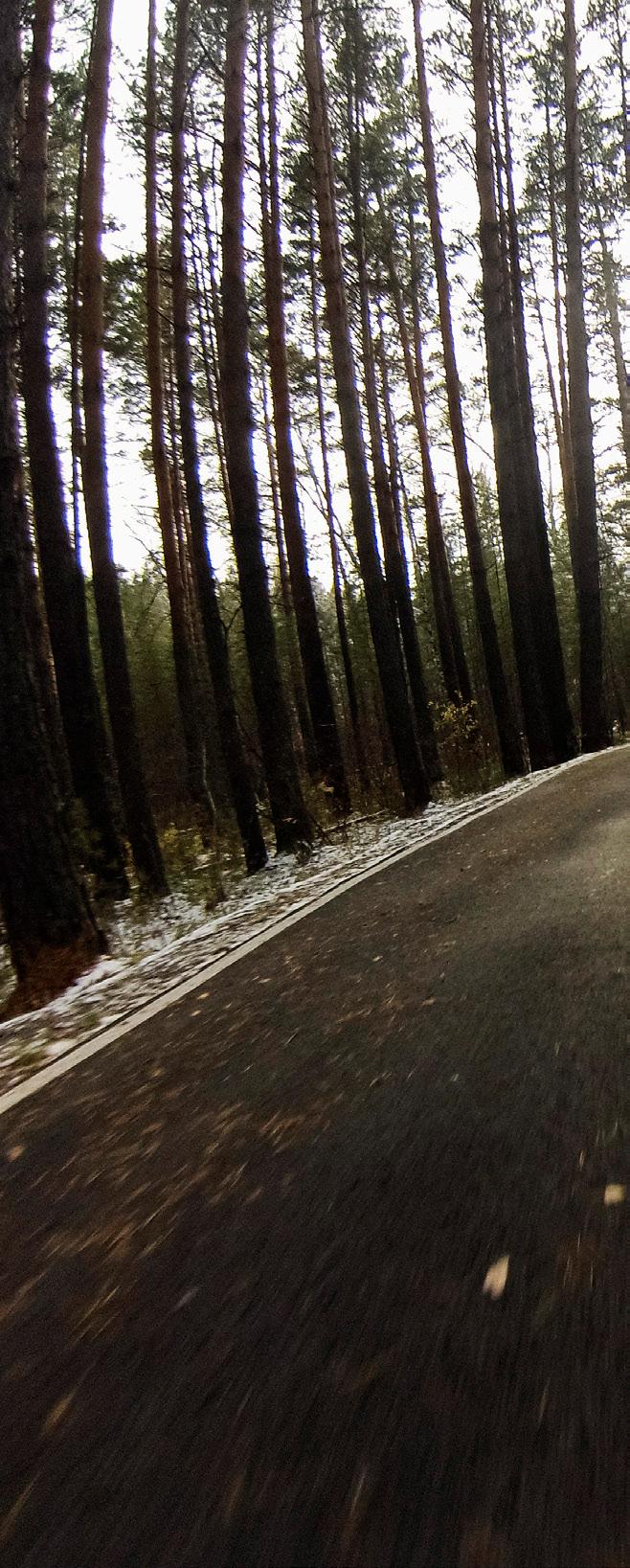
Back in 1976 Jerry Madrid launched his career in skateboarding. You’ll be amazed at some of the truly magical things his company created.
As a race organizer and promoter, Lee Cation faces many challenges. This profile explains how he handles things like rain, technology failure and unruly skaters.
Part six of our ongoing feature on what gear works for skaters.
Monty Little interviews Japan’s outstanding female freestyler Mic Murayama and British Columbia’s Ryan Brynelson.
Electric skateboards have come a long way in the past few years. Here’s a comprehensive look at what’s out there right now.
Our second installment from their 40-year history book.
Whether you’re planning a day trip or something that extends over a period of months, this guide to long-distance travel by longboard will give you some crucial tips.
The Kozakov Challenge takes place on what was once an active volcano. How appropriate the race features three hairpins, steep straightaways and 24-hour party people.
Max Watson doesn’t let a little wet snow spoil his fun.
Photo: Adam Lapierre
Alexander Malyshev challenges the Siberian environment.
FACING THE ELEMENTS 62 RIDER SETUP PROFILES 68 THE ZEN OF FREESTYLE 74 POWER TO THE PEOPLE 76 TRACKER TRUCKS PART 2 82 LONG TREK TRIPS 86 THE SEVEN-YEAR PITCH ON THE COVER: CONTENTS: 48 NOTES FROM DISTANT ROADS 52 MADRID HITS 40 YEARS 58 EYES ON THE PRIZE
Photo: Artem Vladimirov
40

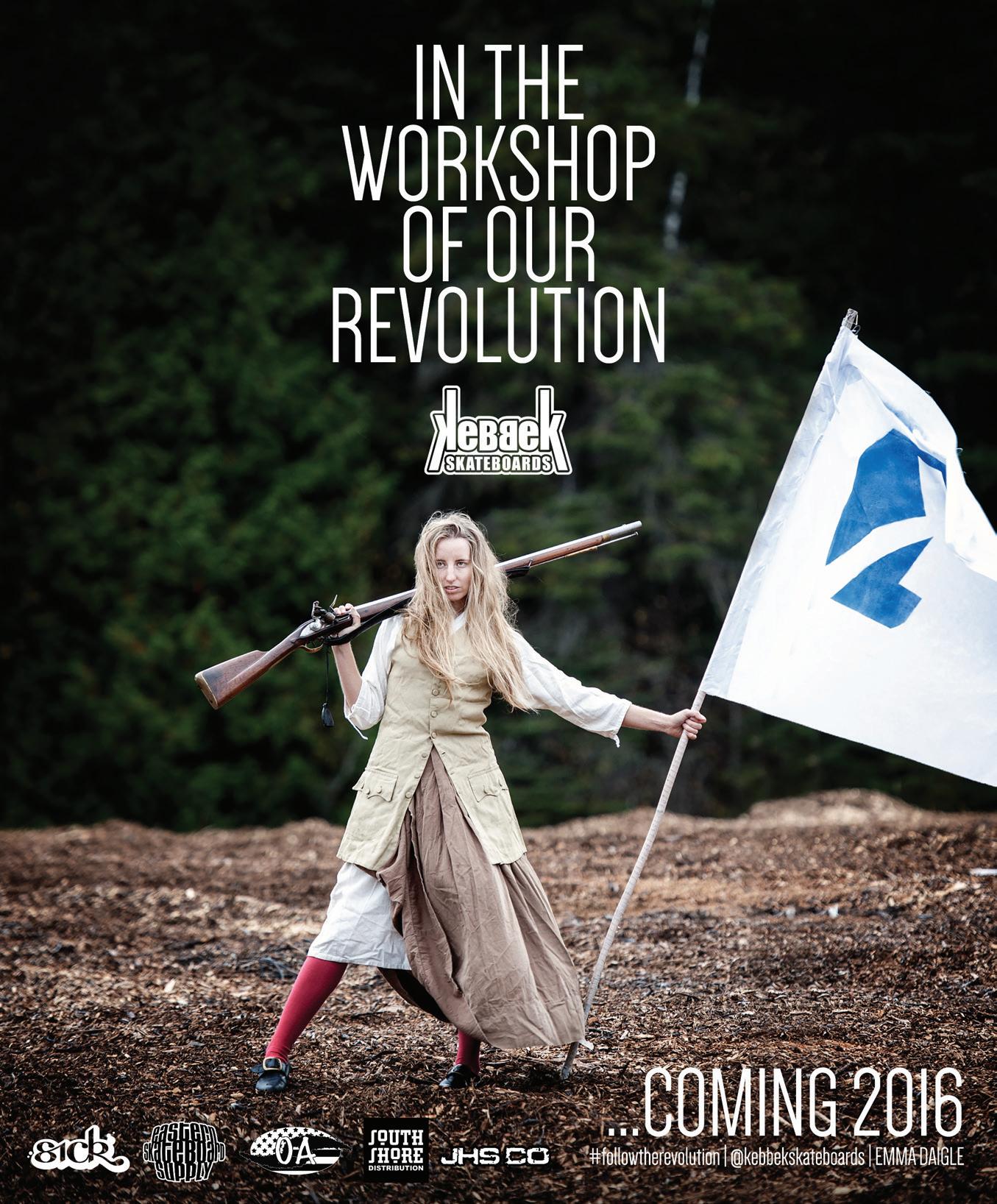

Once again, Mark Short delivers another outstanding illustration. This image perfectly captures the roots of skateboarding and was inspired by a photo Mark found in LIFE magazine. I searched for the original photo and in a matter of seconds I found it. I encourage you to do the same. It’s truly astounding what Mark creates with paper and ink. If you visit his Facebook page, you’ll find he has a number of masterpieces. I originally saw Mark’s illustration on his Facebook page and knew instinctively that it belonged in CW . Our mantra has always been about taking you back and moving you forward. The roots of the “do it yourself” movement can be traced back to kids taking roller skates and hammering them onto two-by-fours. I can think of no better way to celebrate this independent, creative spirit than reproducing Mark’s artwork.

This is actually not the only image in the issue that was inspired by Facebook. Our opening editorial photo was originally posted on the Longboard Girls Crew page. Although it was in black and white and a fairly small image, it conveyed an intensity and power that just screamed, “Find the photographer!” Luckily, we were able to do just that and now Kanya Sesser graces the pages of our magazine inspiring tens of thousands worldwide.
Over the past two decades, I’ve seen skaters take the best of the Web and use it in creative ways to share the stoke. For example, I always smile when people take a photo of their image they find in CWand put it up on their Facebook, Instagram or Twitter account. It’s as though the immediacy of digital meets the permanence of print. Whatever the case, I am delighted to say that we are publishing five new stories per week on our revamped website, and the results have been extremely positive.
The theme of this issue is “facing the elements.” We all have different things that bring us challenges in our lives. It’s just a question of how people cope with these challenges. Skateboarding has been one key element in my life that has helped with so many different things. But then again, if you’re reading the fine print, you already knew that. All the best for 2016!
As we were at press, we learned of the tragic passing of Larry Gordon. Larry was the “Gordon” in Gordon and Smith (G&S) Surfboards and Skateboards. Larry left a tremendous impact on skateboarding, and we will have a full tribute in our Buyer’s Guide.
The Fine Print
Illustration by Mark Short
20 | CONCRETE WAVE - WINTER 2016 THE FINE PRINT
LITE DROP-THROUGH
36” x 9.5” | 27” Wheelbase
Dusters created the Lite Carbon Hollow core technology by combining an ultralight honeycomb core with carbon fiber, which has the strength of steel at a fraction of the weight. The core is created by sandwiching the honeycomb core with carbon fiber and placing within the die cut veneer stack. This construction results in a weight reduction of 15 percent compared to a board of the same shape. After combining the deck with the our 180 mm magnesium Slant reverse kingpin trucks, the Dusters Lite is one of the lightest completes on the market. You’ll be blown away the first time you grab it and even more stoked when you’re pushing through the streets.

15% LIGHTER DEALER INQUIRIES: dwindle.com | +1.800.500.5015 easternskatesupply.com | +1.910.791.8240 oceanavenuesk8.com | +1.321.777.9494 skatenet.com | +1.713.926.3295 /dusterscalifornia @dusterscalifornia
IT’S ELEMENTARY
As I write this editorial, I am staring out my window and enjoying the brilliant sunshine. But the sun’s rays are something of an illusion. The outside temperature is hovering around 32 degrees Fahrenheit (or 0 degrees Celsius). It sure looks like a gorgeous day, but is it too cold to skate? Nope. I plan on going out shortly after I finish writing this piece. I just need to face the elements and dress accordingly!
For those who live in colder climates, the onset of winter can be a mixed blessing. Snow tires are already on my car. The leaves have been raked and we’re ready for the first snowfall. For many (myself included) the changing of the seasons is a positive experience. Many will soon get an opportunity to go skiing, snowboarding or snowskating. On the negative side, the cold and wet can dampen one’s spirits. To say it’s a challenge to ride outside when faced with piles of snow or endless days of rain is a vast understatement.
And yet, as our cover proudly shows, skaters don’t let something like snow hold them back. We dedicate this issue to all skaters (and those in the skate industry) who have faced or are facing challenging elements. You’ll learn about Lee Cation, an event organizer who has dealt with numerous issues at contests. From weather that refuses to cooperate to skaters who also refuse to cooperate, Lee has experienced it all. Our photo section brings you sense of what it’s like to ride in snow, rain and freezing temperatures.
But facing the elements like snow, rain or unruly skaters at an event is only one part of the equation. We ALL face external challenges. In most cases, it boils down to how we navigate these challenges. For example, if you decide that you want to avoid the cold and wet, you can plan to move to a better climate. It might take time, but it is possible. But what if your challenge isn’t so simple? For example, what if you wanted to skate but you had no legs? This is what Kanya Sesser was faced with – yet as you can plainly see, she didn’t let it stop her from riding. Kanya is truly in her element here. I sincerely hope this photo inspires you as much as it does me.

As I have often shared with you, skateboarding has brought me an immense amount of joy and helped me cope with stress on numerous occasions. Concrete Wave’s vision of inclusion, the ride being the reward and sense of community resonates with skaters from around the world. These three elements are an important part of the chemistry of what makes skateboarding so great. Occasionally, nonskaters will come up to me at events and tell me they are astounded by the kindness and generosity they see around them. Of course, I smile and say, “It’s elementary to who we are.”
 Michael Brooke Editor
Michael Brooke Editor

22 | CONCRETE WAVE - WINTER 2016
EDITORIAL

CONCRETEWAVEMAGAZINE.COM | 23
Kanya Sesser in her element. Photo: Seth Shapiro

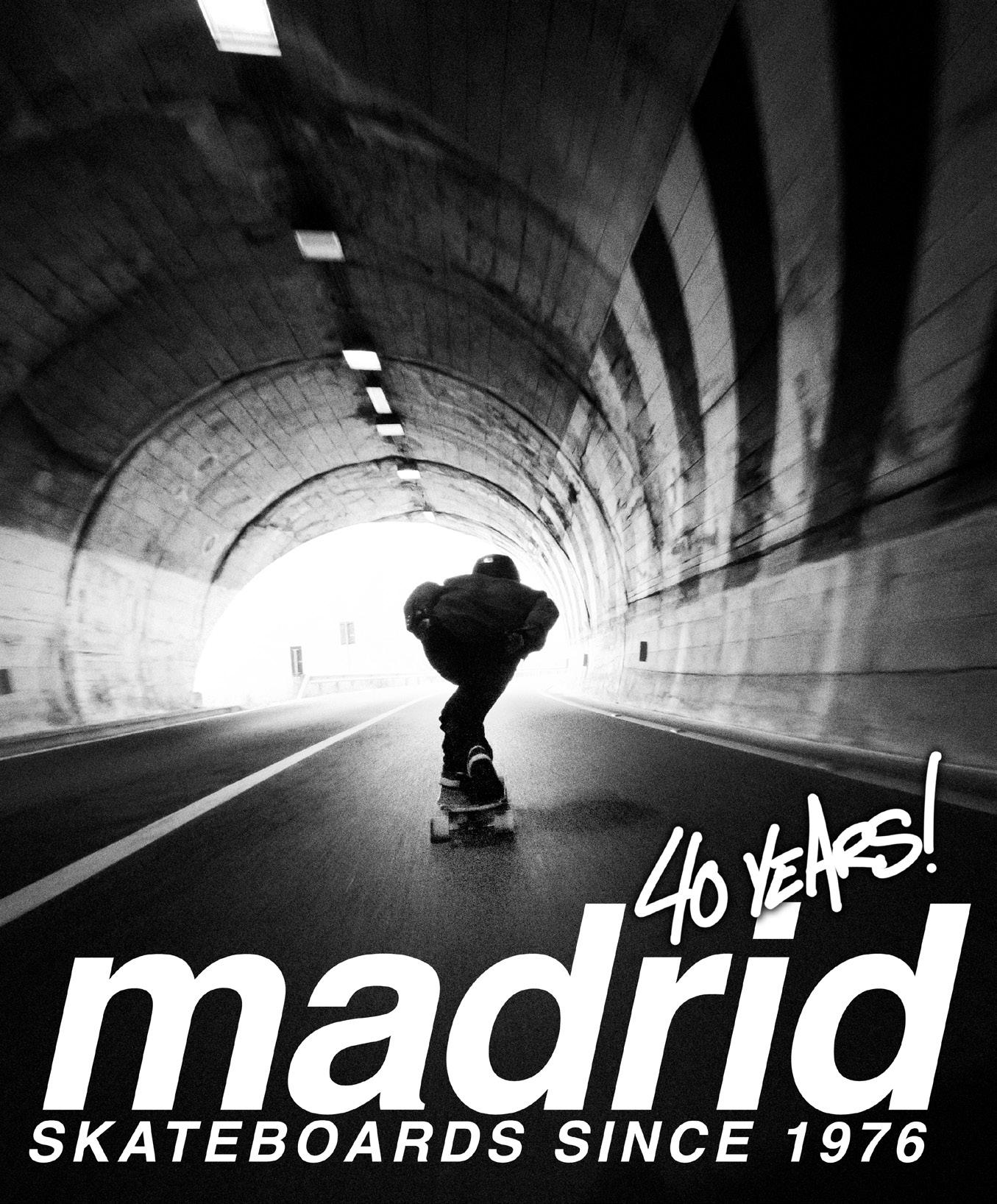
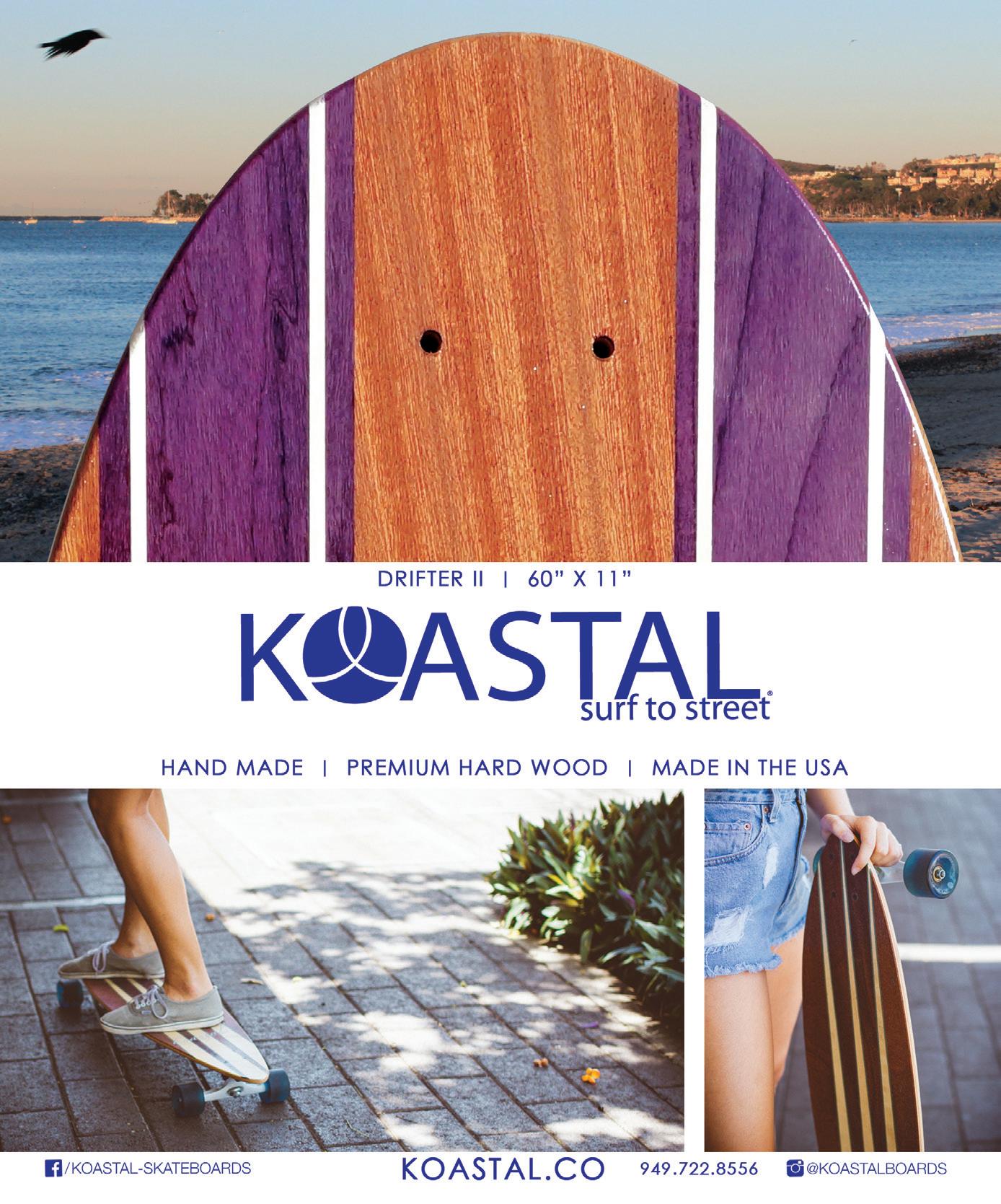


NOTEWORTHY
WEFUNK

Wefunk has introduced three new completes for spring. The 36” Stripes is fast and sleek with a little bit of an edge. The board comes with 180 mm carving trucks and 69 mm/78A race wheels. The 39” Hexagon and 37” Crossed feature 180 mm carving trucks with 83A freeride wheels. All boards are made in Spain with 100% Canadian rock hard maple, flawless CNC production and robotic varnishing. wefunk.de
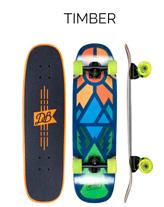

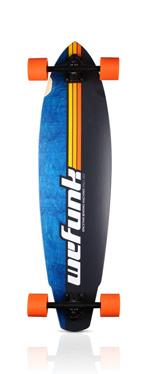
THINGS YOU SHOULD KNOW ABOUT
POWELL-PERALTA






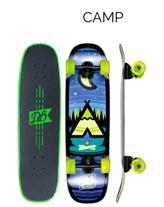



Powell-Peralta has reissued the original graphics from the Bones Brigade. Created by the legendary V.C. Johnson, these images are truly iconic. powell-peralta.com

DB Mini Cruisers are built with versatility in mind. The perfect craft for every occasion, small and lightweight enough to stuff in a locker or backpack while still fully functional to skate at the park. Big soft 78A Cloud Ride wheels and traditional-kingpin trucks make these your new go-to skateboard for just about everything! The DB Mini Cruisers are also available in five graphics and are made of 100% maple. dblongboards.com

DB
-
The Wingman comes in at 36” in length, 9.75” width and a 27.5” wheel base. The deck is perfect for the lighter, smaller but aggressive rider. Featuring a slight “W” concave at an economical price. neversummer.com
NEVER SUMMER
KRYPTONICS ORANGATANG
Kryptonics has released two limited-edition wheels. The 80A pink wheel fills that gap in your wheel quiver between a bit too soft and just a touch too hard. Soft enough for that not quite smooth neighborhood street, yet hard enough to give the roll you need in ditches and other non-skatepark terrain. Available in 55 mm, 60 mm and 65 mm.

The orange 84A is perfect for that butter-smooth street, and also flows well on just about any type of skatepark terrain, be it concrete or wood. A perfect blend of speed, rebound and grip. Available in 60 mm and 65 mm. kryptonics.com


ARTECORE
Beautiful handcrafted skateboards that are made from fine Brazilian wood. Each board is one of a kind and no machinery is used in the process. Our passionate Brazilian artists and woodworkers make sure each board is hand cut, shaped, sanded, painted and finished in an effort to produce true artisan boards. No design will ever be reproduced. Their process guarantees that each skateboard is uniquely crafted, making each one a work of art made especially for you. artecoreboards.com
ARBOR VENICE
The flagship Arbor shop in Venice, California, just renovated its entire skate department. If you’ve got a chance to be in Venice, make sure you visit the shop, located at 102 Washington Boulevard. arborcollective.com

The Orangatang Onsen park wheels continue to blend the boundaries of traditional skateboarding, park riding and longboarding. Designed for park riding in particular, this proprietary new formula, core design and shape were created to find that perfect balance between grip and slip – grippy enough to hold high lines in the bowl, but slidey enough for predictable speed checks and recoveries from sketchy scenarios. The Onsens are poured in a new Orangatang formula, Perky Thane – fast, smooth, grippy and durable. orangatangwheels.com
SPEED DOCTOR
Speed Doctor Legacy 9 Bearings have arrived. Featuring corrosion-resistant races and high-precision stainless steel balls, the bearings are meticulously cleaned with their new Bear-Ing Cleaner, then lubed with our Speed Shot oil. These bearings are fast right out of the package. Whether smashing luge speed records like their team rider Matt Bartlett, thrashing downhill races like Daisy Johannes or outlasting others in push races like Sidra Boyer, these bearings were built for you! speed-doctor.com

PANTHEON
Pantheon Longboards releases the new 2016 Harbinger. A subtly not-quite-classic topmount downhill/freeride deck, the “Harb” features 1/8” crescent micro-drop coupled with aggressive, progressive radial concave, mild wheel flares, mild rocker and a mild rear W. Overall, a true shredder that exemplifies the connection between form and function and a balance between features that are comfortable yet functional. The Harbinger is 36.7” long and 9.9” wide with wheelbases from 25 to 28 inches. pantheonlongboards.com


NOTEWORTHY
R.A.D.
WAIT, THEY LONGBOARD?!
Joachim Stroink
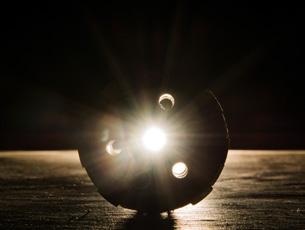
Elected Member of the Nova Scotia Legislature

Joachim Stroink was first elected to the Nova Scotia House of Assembly as Member of the Legislature Assembly for Halifax Chebucto in 2013.
What is your skateboard history?
Rider Approved Designs introduces the Jimmy Riha Influence. This pro-model wheel features a proprietary urethane to maximize the ease of sliding. The smaller, versatile shape is ready for anything from downhill freeriding to city crushing. It features the Crown Core with a 63 mm diameter, 34 mm contact patch, and 80A durometer. This wheel is designed to have fun wherever you find yourself skating. radesigns.com

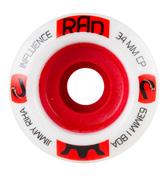
BRAND-X
Known for their loud graphics and eye-popping colors, Brand-X has returned. Bernie Tostenson was the man behind the boards, and his graphics inspired a generation of skaters. Like their predecessors, these beautifully silk-screened decks were proudly made at Watson Laminates in San Diego. brandxskateboards.com
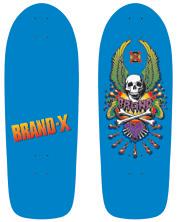

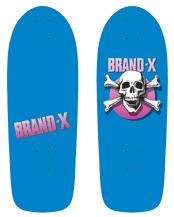
SYDEWYNDER
SYDEWYNDER Spring 2016
I used to skate all the time growing up; it was my way of getting around. I owned a Vision Psycho Stick and a Gator. It’s how I got around. When I got my first job at O’Brien’s Pharmacy, I used these two boards to get to work. I did not really get into longboarding until my late 30s after I had kids. My daughters gave me a Sector 9 Bob Marley board. I now use it as my main form of transportation. I use it to get to and from the office and the legislature. Personally I feel a lot safer on a longboard than any other forms of active transportation. It gives me more control and ability to keep out of people’s way.
Why did you decide to run as a politician?
We can all be very good at complaining. I was at a point in my life, with four businesses, where complaining wasn’t enough. I was becoming more and more frustrated with government and their relationship with business. I tried to get involved with the previous government, got nowhere and decided I had to step up. Fed up and eager to make change, I sought the Liberal nomination in Halifax Chebucto.
When you finally wound up winning the seat, were you surprised? What was it like to skate to work the first day of the legislature?
I was very, very surprised. My riding has a long history as an NDP seat. (Ed.note:Here“riding”means “electoraldistrict,”andNDP=NewDemocraticParty,arivalofStroink’sLiberalparty.)I think they were just as surprised as I was. As for arriving in the legislature, I had to throw on a suit, and it left me wondering how to stay real. Getting there on my longboard was one way to do that, to stay true to the things I value and to ensure that I was putting active transportation and board issues on the radar. It’s a 2- to 3-kilometer run to the legislature from my home/office. I still get the occasional “look” riding past people in a suit with my tie flapping in the wind on the way downtown. What’s funny is how the board opens my eyes to the generational change that happens. A number of my colleagues have been in the legislature for some time; for them, the idea of arriving on a long board is new and interesting. I still get looks from colleagues, too.
What have been some of the most rewarding aspects of the job?
Meeting people – hands down. Whether it’s on their doorstep, in my office or in the community, it has been the most rewarding part. The ability to help people and listen to their concerns and help find solutions is the best part of the job. Working on committees, with departments and my colleagues to shape the future of the province is an amazing honor and responsibility, and we all take it very seriously. I have direct access to the Minister of Transportation. That’s face time with the person best positioned to take action on boarding, cycling and other active transportation issues.
What have been some of the worst things about being a politician?
The worst thing is the partisan attacks. It didn’t take long after the election to see how harsh people could be. People said as a politician, I’d need thick skin; I would never have guessed it would be like this, though. My kids have seen “Wanted” posters with my photo on them on their way to school. People have picketed the family business. It has been difficult. For the first year I really struggled with it. But at this point, I just have to let it roll off my back. In politics, in government, no decision will make everyone happy, and some decisions really anger some people. This is par for the course.
Sydewynder wheels are proud to be the world’s first and only wheels of their kind. This brand new patented design features 36 urethane rollers that allow the wheel to roll forwards, backwards and sideways. This combination not only gives the rider the ability to ride with complete control in any direction possible, but provides the smoothest slide possible. It also dramatically increases the life of the wheel. The Sydewynder will be released in a 65 mm diameter with a duro of 83A. staabenterprises.com
CORRECTIONS / OMISSIONS
The photo of Per Canguru on p. 75 in the November issue was taken by Rodrigo K-b-ça Lima at MAC USP –Museum of Contemporary Art in São Paulo, Brazil.
In the November rider profiles, Troy “Yardwaste” Grenier wanted to give a shout out to his shop sponsor, Flatspot Longboards in Vancouver. Flatspot also has a new website at flatspotlongboards.com.
 by Luke Ayata
by Luke Ayata
Asmany of you know, this past October was the Broadway Bomb in NYC. For those who don’t know, the Bomb is an 8.6-mile outlaw race that starts on 116th Street, cuts straight through the heart of the city and finishes by the Bull by Wall Street. It is dubbed the most dangerous skate race in the world because it happens in open NYC traffic and in the middle of the day.
Over the past decade, the numbers have grown from the 16 original attendees to over 1,500 at its peak a few years back. With the growth of the numbers, the race gained popularity as well as becoming a problem for the NYPD. Even though the race was handed off to Ian Nichols, he set it free a couple of years ago. No one really owns the race so there is no one to blame.
I believe this year the NYPD realized that it was going to happen no matter what. They showed up in numbers and conducted themselves very professionally. They actually were prepared and worked in unison to make it a safe experience for everyone.
The Shralpers Union crew had people in town from many chapters and took full advantage of the whole weekend. First there was the Uncle Funkys meetup, where the Union members got to meet some the local talent as well as catch up with people from other chapters. We spent the night sharing stories and reminiscing. As usual anyone who needed a place to stay found a warm home and open arms of a Union member.
Saturday morning was breakfast and getting recon before the race. We didn’t know what we were in for. At noon the race started and as a group we took the secret route in order to avoid the 20 blocks of mayhem; then it was every
man for himself. It went off without a hitch. Union riders Kiefer Dixon (Bustin) and Cami Best (Sector 9) took first place for men and women.
Next was the BBQ that takes place right after the race. Sector 9 provided burgers and the winners were announced. Lots of schwag was given away. We brought the party with us everywhere we went, all the way back to the NJ headquarters.
Sunday morning started out with Uncle Funkys Style Sessions, which have become a classic. Next we explored the pump track in Brooklyn and plan on adding it to the festivities next year. No one really got any sleep, as we only get to unite twice a year – once at the Bomb and once again at Ultraskate in Miami.
Another date that is now sadly permanent is Dec. 6 – the day one year ago when Union founder Noel Korman and his girlfriend Alice passed away. Before he passed, Noel had been getting ready for a chili cookoff sponsored by GRZLY and Shralpers Union. In his honor we plan on making it an annual contest.
This year Union member Eric Liaci took home the gold as all of Noel’s friends gathered to embrace his memory. The turnout was great. Besides our usual group of misfits, the original Batmobile was on the premises for the event (Bruce Wayne’s vegan chili didn’t stand a chance). One guest that really blew us
away was that John O’Malley showed up. John is a living legend credited with creating California’s first skatepark, Carlsbad Skatepark (and the Concrete Wave Skatepark).
The cook-off raised over $700 for the homeless and we will be donating it to a local church. The show of love and outpour was priceless. At one point I caught Noel’s dad, Razor, shedding a tear or two quietly. I know Noel was up there grinning from ear to ear.
Heads Up:
A crew of us is planning a skate across the country from Seattle to NYC (5,400+ miles), on which we will stop by many of the chapters.
May 2016 is the official launch of the Shralpers Union movement.

32 | CONCRETE WAVE - WINTER 2016
SHRALPERS UNION UPDATE:
Contact us at shralpersunionllc@gmail.com Follow us on Instagram: shralpers_union Join us: shralpersunion.nationbuilder.com
Shralpers Union riders celebrate at the end of the 2015 Broadway Bomb. Photo: Lori George


LIVING AS A LEGEND
By Kurt Hurley
The Bridge has been running for two years now in Concrete Wave. My intent all along has been to grace these pages with legendary skaters who changed the history of skateboarding forever.
Biker Sherlock definitely fits that description. Biker’s story has been documented in this magazine before: owner of Dregs Skateboards and leader of Team Dregs; world champion and multiple X Games and Gravity Games champion in both downhill and street luge; entrepreneur and race promoter; and much more. Biker wanted downhill skateboarding to be recognized for just how exciting and radical it was, and is. He singlehandedly talked NBC into creating the Gravity Games –and however controversial the path he created was, it certainly laid the groundwork for the future of downhill skateboarding.
Biker lived it every day, too, and not just on a skateboard. He was an incredible big-wave surfer who was recognized enough to be asked to drive Jet Ski support at big-wave events. He was so good at racing trucks that legendary truck racers said he should drop everything and focus on doing that instead. Biker was gifted. He was a legend. He had vision.
Biker had it all: a beautiful wife and kids, friends who loved him, and a legacy of being one of the greatest downhillers of all time. I was fortunate to travel the world with Biker and Amy while I was racing with him as part of Team Dregs. He was a rock star. I looked up to him, as did many others who knew what he stood for.
Biker’s life and career were connected with those of well-known industry insiders like Steve Lake from Sector 9, Michael Bream
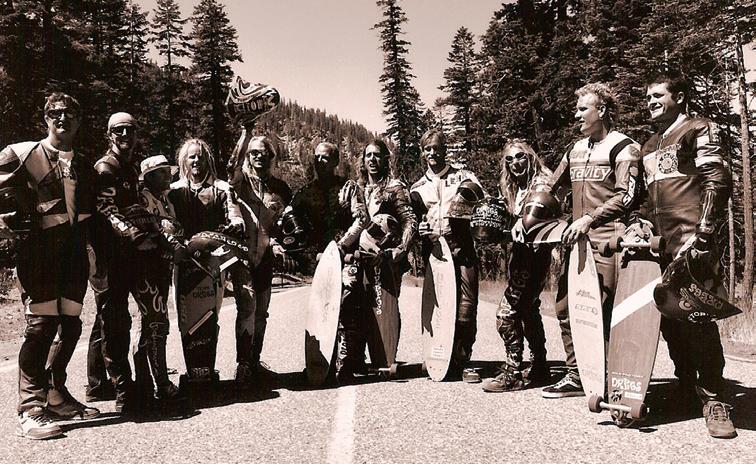
MICHAEL “BIKER” SHERLOCK
from Gravity Skateboards and many others. Brad Strandlund, a great longboarder from the ’70s, is also a key figure in the Biker (and Dregs) story. Brad certainly nudged Biker in the direction of downhill skating and should be duly noted as a friend and business partner. Some of you may also know that I was vice president of Dregs for a while and initiated the marketing campaign to show the younger generation just how meaningful Biker was to the proliferation of downhill skateboarding.
Still, living as a famous athlete can be hard, both mentally and physically, and even legends take a beating. Nearly every day we hear about the damage that pro football players, boxers and other athletes sustain from the constant pounding of their chosen sports. The risks for downhill skateboarders are no less severe, and Biker certainly suffered his share of wipeouts, crashes and injuries. Did the effects of concussions and other head trauma play a part in his death? It seems now that this is the most likely scenario.
Besides my own grief, I am also devastated by the loss for Biker’s family.
When you have children, everything changes. You find out what true love really is. It is the greatest gift of all to be blessed with beautiful young lives. Nothing can ever change the love you have for your children, and no father loved his children more than Biker. He was an incredible dad who spent a large amount of time with his two boys. They worshipped the ground that he walked on, and for good reason.
We will never forget you, Biker. Thank you for all you have done for all of us in the skateboarding world. We miss you.
CONCRETEWAVEMAGAZINE.COM | 35 A TRIBUTE TO
Dregs at Mammoth Mountain, California.
THE BRIDGE
A PIONEERING SPIRIT
By Michael Brooke
I was in New Jersey when I heard the news that Michael “Biker” Sherlock had passed away.

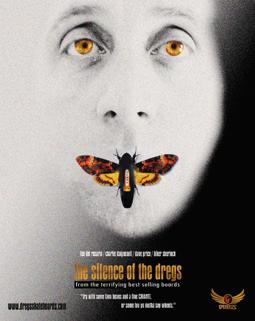

I met Biker over 15 years ago. He was one of the first people to advertise in International Longboarder Magazine when it came out in August 1999. I’m glad Biker saw something in that publication. I was grateful for his support.



Biker was truly a pioneer. He pushed things forward in so many different ways. His legacy in the downhill community will never be forgotten.
When Biker advertised Dregs in Concrete Wave, his tag line was “all the elements.” Biker truly pioneered this idea. He understood the concept of riding everything and giving everything when you ride.
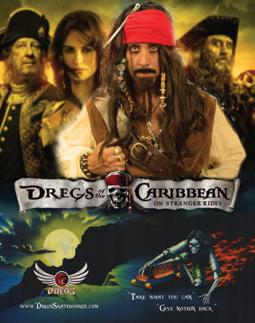
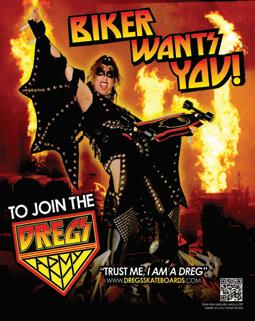
Truth be told, there were a number of times Biker and I didn’t see eye to eye. Dregs will go down as the only advertiser in Concrete Wave who had two separate ads banned – one for including the F word the other equating fellow competitors to dog poop. To be fair, however, Biker’s creative use of the print medium made for some pretty amazing ads. We’ve reproduced a few of them here, knowing they will bring a smile to your face.
Over the years I pretty much got used to Biker’s somewhat brash personality. But things started to change in 2013. In the summer of that year, we met up in Carlsbad. The first thing I noticed is that he had cut his hair. He also spoke differently to me. I could tell the days of us not being on the same wavelength had passed. Circumstances change, and as a result they change people as well.
We visited with his new distributor and had a Japanese lunch together. I spent the better part of three hours getting to see a different side of Biker. This side was not brash. It had passion and pure heart. I am pleased to say that we parted that day as business associates and friends. That day was the last time I saw Biker. It is the memory I have of Biker now. For this I am truly thankful.
36 | CONCRETE WAVE - WINTER 2016
A LEGACY IN PRINT


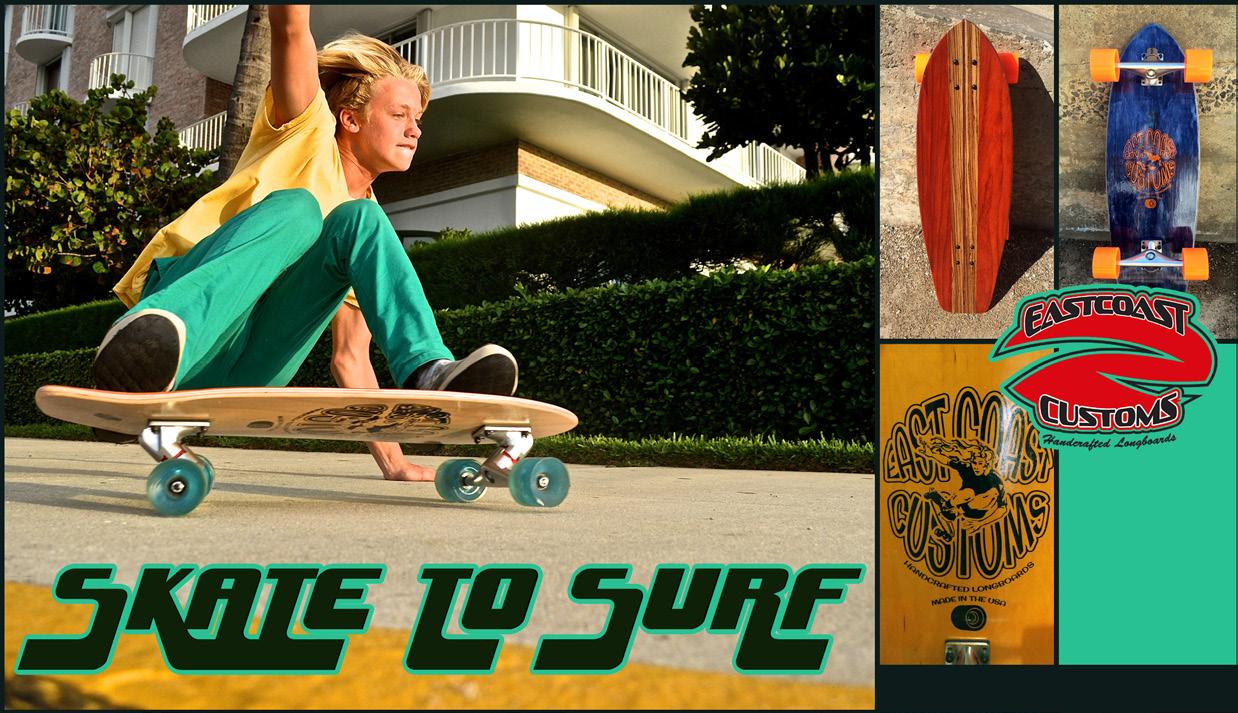



A lot of people like snow. I find it to be an unnecessary freezing of water.
- Carl Reiner
Over the past year, Concrete Wave has presented photos of riders in environments ranging from darkness to sunsets. This time we’re adding various forms of water to the mix. We also decided to forgo the quotes and just let the images speak for themselves.

40 | CONCRETE WAVE - WINTER 2016

CONCRETEWAVEMAGAZINE.COM | 41 Florent Carles. Photo: Maxime Lassale

Many spectators view skateboarding as a hazardous activity, even in dry conditions, and wonder why we challenge ourselves the way we do. Riding in rain or snow seems even crazier. Yet riders all over the world are doing it – for the challenge, for the experience, or simply because they have to. With forecasters saying the current El Niño will cause all sorts of precarious predicaments, you might as well enjoy it if you can. So, channel your inner meteorologist – face the elements!


CONCRETEWAVEMAGAZINE.COM | 43
^ Martin Arthus. Photo: Alban Pernet << Dodging through the fog. Photo: Maxime Lassale < Philipp Schickor. Photo: Holger Schickor
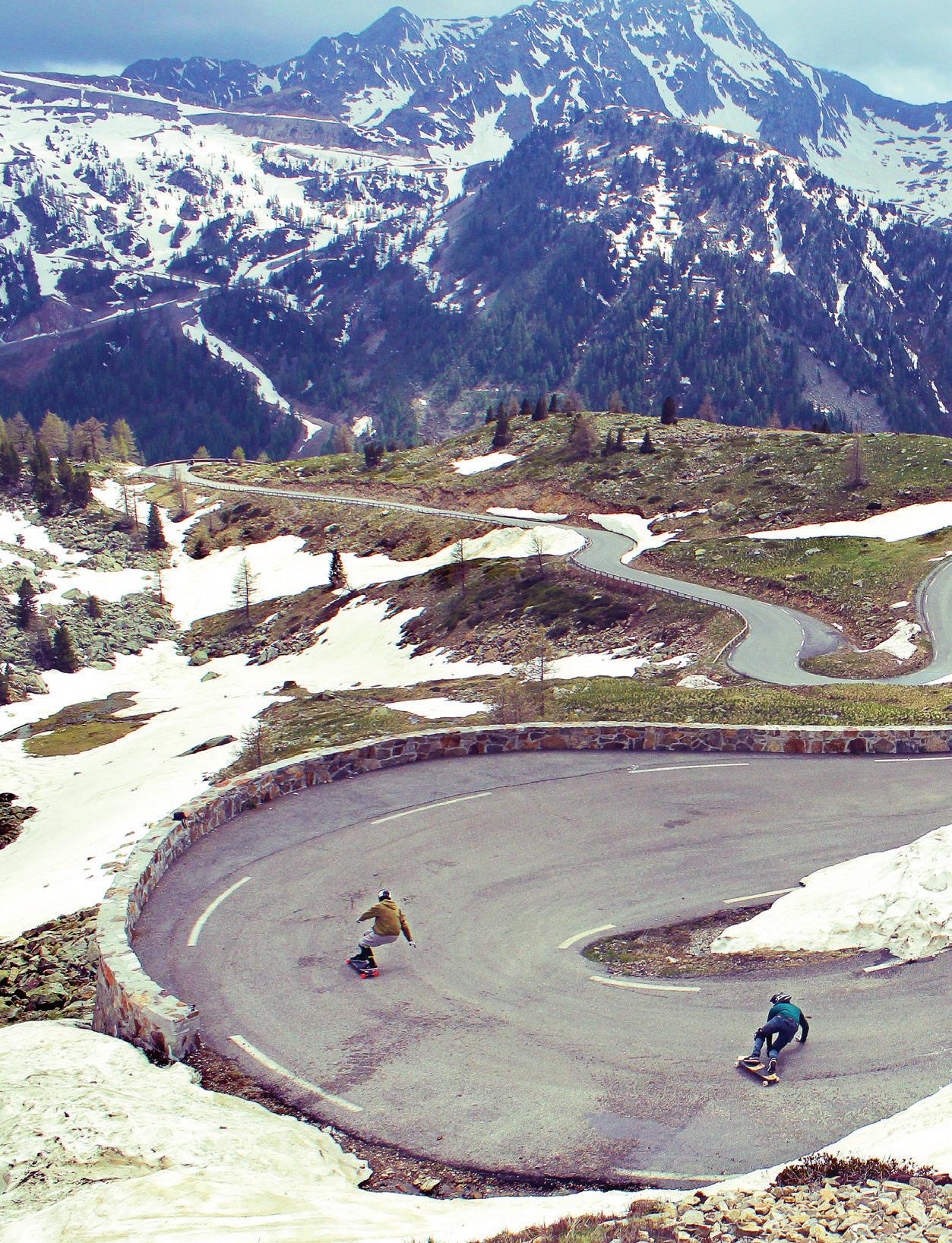
 Photo: Maxime Lassale
Photo: Maxime Lassale


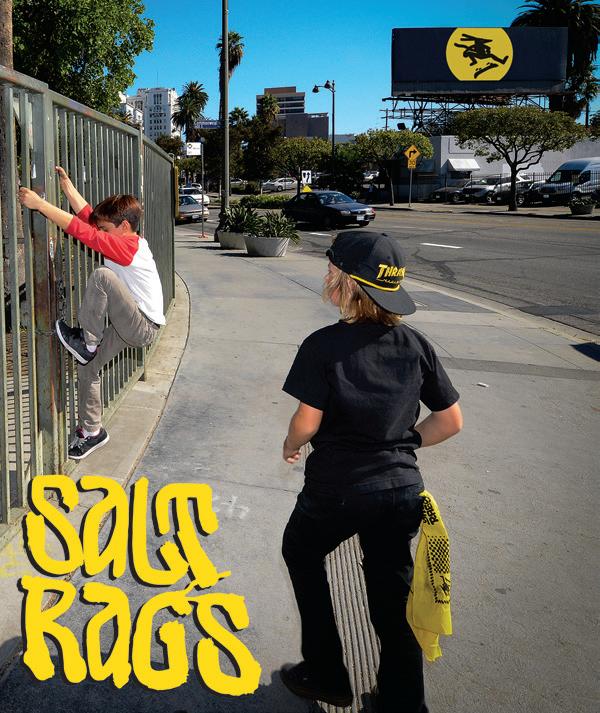



NOTES FROM DISTANT ROADS
 By Andreas Nout Schmidt
By Andreas Nout Schmidt
Istep on the board and leave the town of Aomori, located in the northernmost region of Japan’s main island, Honshu. I’m eager to skate on deserted country roads that will lead me deep into the hilly heartland, famous for its dense forests and many rivers.

This is Tohoku, a mostly rural part of an otherwise highly urbanized or inaccessibly mountainous country. What bliss it will be to skate from one farm town to another, with nothing to worry about except perhaps where I will set up my tent for the night.
Oh, yes, what bliss. But what the heck? I follow the recommendation of the ladies in the tourist office to take a safe road to the next town, as any other route would probably kill me. I could handle the steep and curvy mountain roads, but the thought of narrow roads with barely enough space to evade approaching cars while circumnavigating potholes and isles of gravel makes me uneasy. Getting killed on my first day would be a bit of a bummer. I have been looking forward to visiting Japan for about 15 years. So I think, “All right, let’s play it safe for now,” and choose the quiet road.
The “quiet road” ungraciously turns out to be a highway. Trucks rush past only inches away as I push forward in a breakdown lane that’s so tight, it’s only good for breakdowns of the mental
kind. For the next 30 miles I find numerous reasons to follow my own nose from now on. With me being the only culprit of my misfortune, at least I know whose nose to punch.
The town I am aiming for turns out to be quite the city: Hirosaki. Cities reach far into Japan, as there’s only so much space for urbanization. Heading east for the moderately mountainous heartland, I find myself skating a road with never-ending usedcar dealerships and other enterprises with similar visual charm. Bliss, where art thou?
Ah, there you are. Gradually, the settlements thin out and wildlife kicks in. Hills become higher as the towns get smaller. I’m soon surrounded by woods on roads with little or no traffic, while the autumn sun shines through maple leaves so brightly red and yellow you’d think they would glow in the dark. The sound of wheels on the asphalt mixes with chirping birds and splashing water from nearby rivers. Could there be anything better?
Hold on, I forgot something: The uphill slopes get steeper with my every push until I’m death-rattling for air. I could have brought a light and low drop-down deck instead of a massive hybrid cruiser. But then again, I’d have no kicktail to mount some curbs while cruising at high speed through the cities – whenever that will happen.
CONCRETEWAVEMAGAZINE.COM | 49
I’m far from residential comforts as I freeze into sleep at night in the tent. But what can you do? After 15 minutes on the board, my muscles relax and the pain in my back gives way to new experiences of awe.
Nevertheless, as the pleasure rises, the challenges become more demanding. It’s one thing to climb hills on foot with a 15-kilo backpack on your shoulders, a camera bag dangling from your neck and a 1.5-kilo homebuilt oversized camera rig constantly in the grip of your right hand. It’s quite another to skate downhill with all that stuff onboard, especially when you find yourself on the very roads the ladies from the tourist office warned you about.
Sliding in order to reduce speed becomes somewhat suicidal under those circumstances. What’s the next best thing that will be less likely to get you killed? Pushing your foot against the asphalt. It works, but it has two downsides: It looks stupid, especially at high speeds when you are also trying to keep your balance by fluttering your arms madly like a high-wire circus artist caught in a wind tunnel; it also leaves you hobbling by the end of the ride as you grease the mountain with the better part of your braking sole. In fairness to your shoes, you plan to skate the next downhill switchstance.
After traveling for almost a week, I finally reach the town of Tono, famous for its folklore. I arrive late at night after riding the last 20 miles in icy rain (with winds to match), only to find there’s no room available in this isolated town on a random cold autumn night. As I rest in a hotel lobby, one young clerk approaches me and expresses interest in my skateboard. This is no surprise, as anyone I’ve come into contact with has been eager to find out exactly what I’m up to with this thing. My Japanese is clumsy at best, but it doesn’t take a genius to realize that everyone is flabbergasted about my long-distance endeavors – to the point where people have been clapping and giving me the thumbs-up when I pass by on the street. But this time I’m in for a surprise, as it turns out this lobby boy has been skating for about five years. I realize that there’s no town too remote to shelter a skateboarder. I can relate, having grown up in a lonely farm town with the first skate obstacle being cow droppings I had to ollie over. Naturally, this renders one an ollie expert.
I am stunned days later in the city of Sendai, in a night of busy Halloween action, when a young guy approaches me, asks for my board and manages to ollie impressively high with it. It’s even more impressive when you consider that my board is nothing but a clumsy cruiser with no grip tape, as it has been polished off by the heaps of wet mud I’ve ground into it while skating dirty roads through the rain. It’s a slippery, nerve-wracking experience when practiced on roads with challenges of their own.
For the next stage, I opt for some calm and take the train to Kanazawa, a town located in central Japan on the western coast facing the Sea of Japan. From there, it’s 90 miles of mild coastline skating fun until I turn left and head inland for another 90 miles to reach the city of Kyoto.
For someone like me living in Berlin, the cleanliness of Kyoto is a shock. However, as good as Kyoto looks, it lacks the signs of a colorful society. In other words, it doesn’t have many people who don’t give a shit. I speak with a Japanese man who reluctantly had
to return there after taking two years off in Australia.
“People are becoming robots here,” he says. “It’s all too stiff, like living in a museum. Everyone blindly follows the order.”
“What about skateboarders?” I ask, “A comprehensible disregard of the establishment is essential for street skating. Waxing, grinding and eventually breaking don’t go very well with these surroundings.”
“Skateboarders there are,” he says with a wry smile. “They wax and they grind. They are not giving in.”
The entire conversation leaves me wondering. Throughout my trip I’ve been greeted with utmost joy and respect absolutely everywhere, especially by the elderly. Still, the religious and cultural life in Japan is based on cleanliness, outside and inside. As far as the outside goes, a skateboarder must be viewed as an absolute renegade, a social outlaw. Are the people I’ve encountered just amazed to see a handsome tourist (kakkoii, I keep hearing all the time), or is it more than that? Can it be that a breath of fresh air is desperately needed in this aging society? There is much stress on the youth as the country strives to uphold social norms to a point where it leads to severe and widespread depression and anxiety.

50 | CONCRETE WAVE - WINTER 2016
When the Japanese see me stand and roll, do they view it as a sign of progression?
I’d like to think so. I’m certainly treated differently as a tourist, but then again, the people are not exactly welcoming outsiders, as we can potentially be a source of unrest. By starting every conversation in Japanese, I’m often mistaken for a resident, as it happened in northern Honshu and southern Shikoku. When I take myself out of the picture, I’m still unsure whether the politeness is heartfelt or just a formal excuse not to mind each other.
Attempts to make sense of Japanese culture and all its contradictions often fail. But then again, as the concept of recurring failure is a matter to which every skateboarder has to grow accustomed and eventually overcome, there’s enough energy and self-confidence (not to mention just plain stubbornness) that’s freed up to face some bone-breaking challenges for a change, such as questioning and overcoming the excuses of society.
Cruising through Hiroshima later one night, I accidentally find myself amidst a group of skateboarders pulling their last tricks of the day. How awesome! There’s nothing like the atmosphere of a relaxed night skate session, being welcomed and handed a proper board to join in on the fun. We skate a good curb spot near Memorial Park, a place where it’s unheard of to even ride a bike. Embracing this scenario with the words of the fellow in Kyoto still echoing in my head, I find a way to tackle that sociological puzzle.
Skateboarding does, in fact, have a long-lasting effect on your life, your persona and your perspective; I think everyone having grown up or grown old with the sport will agree. With skateboarding philosophy hard-wired into your soul, one’s racial, ethnic or monetary background becomes insignificant; you are respected for the things you do with the board and your passion, and there’s no room for charades.
Recently, skateboarding has even become a means to bring young people of different colors and creeds together in war-torn territories. It’s also enabled girls to engage in a sporting activity, as in certain cultures skateboarding is not regarded as one. Yet even in the most stable and peaceful developed countries, it’s not far-fetched to think that skateboarding also has the power to gradually eradicate outdated norms and build a more diverse and progressive society built on a common sense of respect. Afghanistan, Israel, Japan – what’s the difference? In terms of skateboarding: none. And the best thing is, while continuing my journey through remote valleys and villages, I know that everyone can be a part of it and make a statement.
Whether on a longboard cruising exotic countries or ollieing over cow droppings … just keep on skateboarding.
To find out more about this trip, write to hello@thenout.net or visit skate.thenout.net.

FOREWORD
This year, Madrid Skateboards celebrates its 40th year as a skateboard manufacturer and brand. In an environment as unpredictable as the skateboard industry, strong leadership is essential if a company wants to stay around, and owner Jerry Madrid’s leadership has allowed Madrid to weather the industry’s booms and busts over four decades. Fueled by his passion for skating and surfing since day one, Jerry and his company have remained committed to supporting skateboarders every step of the way.

52 | CONCRETE WAVE - WINTER 2016
Jerry Madrid taking a cruise, circa 1976.
Photos courtesy of Jerry Madrid
THE MAN
In 1965, while in high school, Jerry Madrid started a small surfboard company. Working out of his parents’ garage in Norwalk, California, Jerry began shaping and fiberglassing surfboards for himself and his friends.

At first it was more of a hobby than a sustainable career, so Jerry took on some additional jobs to sustain his surfing habits and go on more surf trips. After working at a dairy store, Jerry was hired as a journeyman mechanic for Volkswagen in the early 1970s. Working at Volkswagen expanded his technical skills in a way that would later translate to his board manufacturing.
When Jerry and his friends were just beginning to skateboard, surfing was still paramount, and they thought of skateboarding as a way to stay in shape for surfing when the waves weren’t good. While working at a surf shop that made fins, Jerry made his first skateboard out of fiberglass. He continued to cut out small, surfinspired boards to be mounted with metal or clay wheels and whatever other components he could find.

CONCRETEWAVEMAGAZINE.COM | 53
Jerry driving down the line.
A sampling of Madrid surfboards.
That was until 1973, when Frank Nasworthy introduced the first urethane skateboard wheels. Nasworthy’s Cadillac wheels were dramatically faster, more durable and smoother over uneven pavement than clay or metal wheels, and urethane quickly became the standard. The wheels’ increased performance helped skaters push their limits, which in turn drove changes in board design.

“At the time [we were doing] downhill, skating banks and ditches and pool riding,” Jerry says. “As those types of skating demanded different types of boards, we began experimenting with the skateboards we were making. We used various laminations of fiberglass, Baltic birch and maple to get boards to the right level of stiffness or flex for specific styles of riding. At the time, nobody was manufacturing molds designed for skateboard lamination. I had to design molds and build presses to accommodate the various blanks we wanted to laminate.”
To help support his board making, Jerry began working as a firefighter in Anaheim in January 1975. He had to put the skate company aside during his probationary first year as a firefighter, but on Jan. 6, 1976, he was able to officially start his skateboard company, Madrid Skateboards. Jerry continued working for the Anaheim Fire Department until retiring in December 2005.
“THE FARM TEAM”
To promote the brand, Madrid often sponsored small contests around the country. It was a grassroots approach, targeted to smaller events like backyard ramp and pool sessions. Sponsoring these contests attracted new team riders, and the Madrid brand began to grow. Some (but not all) of the early Madrid team riders include: Mike Smith, John Lucero, Bryce Kanights, Bob Schmelzer, Beau Brown, Bill Danforth, Eddie Elguera, Gary Sanderson, Ken Park, Steve Douglas, Rob Roskopp and Roger Hickey. In certain circles, the Madrid team got the nickname
“The Farm Team” because so many riders went on from Madrid to ride for other major brands.
By the late 1970s, the Madrid name and reputation had attracted the attention of some of the top skate companies, which looked to Madrid to manufacture their boards. Jerry began making boards and molds for Santa Cruz, Sims, Variflex, Alva, Vision, Hosoi and others. Pro riders from these brands would come in to the Madrid factory to work on their shapes and test out new prototypes.
54 | CONCRETE WAVE - WINTER 2016
THE INNOVATION
During this era in the late ’70s, a manufacturing error at the Madrid factory changed skateboard design forever. When a few boards were mistakenly pressed without any layers of crossgrain veneer, the blanks began to warp after they were removed from the presses. Jerry decided to cut out the boards anyway to see how they would ride. Without the cross-grain plies, the boards lacked strength and stiffness, but their concave surface felt great. Jerry then set out to make the first production molds with concave. One of the very first of these molds was sold to
Santa Cruz, and Madrid put out its own production board with concave in 1979. The Madrid 36” and 40” Longboards were the first longboards to feature concaves, and the Roger Hickey Downhill Pro Model was the first downhill-specific board with concave.
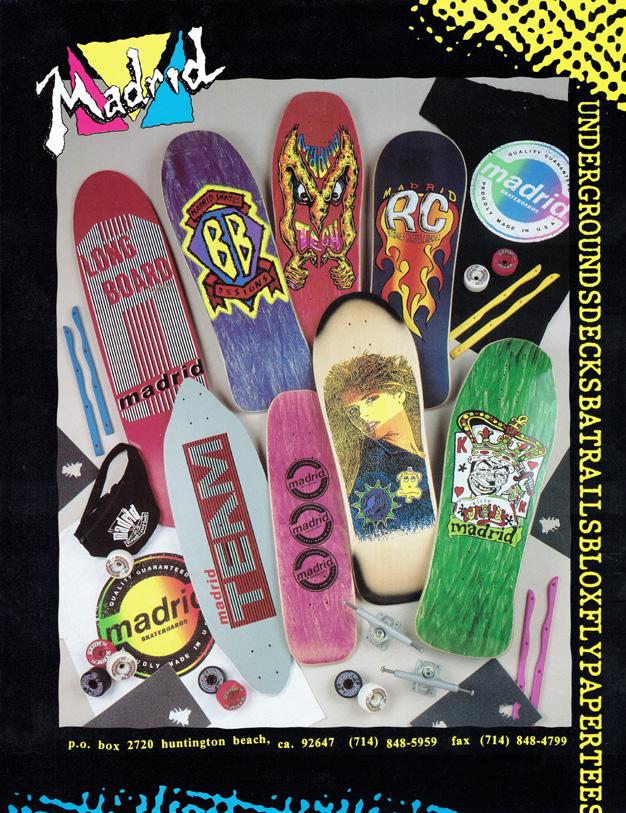
Jerry continued to refine his concave molds and incorporate new features. The M-Tech mold in the early ’80s was one of the first to have an upturned nose and became a staple of the Madrid lineup.

BACK TO THE FUTURE
In the summer of 1985, crowds of families flocked to theaters to watch what would become one of the decade’s most popular movies, Back to the Future. Before production, Universal Studios approached Jerry with an offer to include Madrid product placement in the movie for $50,000. Jerry split the cost with Valterra Skateboards. He produced the boards for the movie with Valterra graphics, but was allowed to add Madrid stickers, and astute observers noticed the Madrid logos showing on main character Marty McFly’s skateboard. Jerry also connected Universal with the stunt riders for the movie (Bob Schmelzer and Per Welinder) and charged Universal $25,000 for props and services. So in the end, Jerry paid nothing out of pocket, and Madrid got a boost in brand recognition. In 2015, Madrid commemorated the film’s 30th anniversary by reissuing a limited run of Marty McFly Valterra skateboards.

THE FIRST GRIP TAPE BRAND
In 1983, Madrid employee and team manager Beau Brown started punching fly-shaped cut-outs in the grip tape that the Madrid factory was supplying to riders. That way everyone who saw the fly would know the board came from the Madrid factory, even if it was produced for another brand. In doing so, Beau created the first skate-company grip tape brand, Flypaper, which is still made in the USA and trusted by skaters of all disciplines.

56 | CONCRETE WAVE - WINTER 2016
Marty McFly’s Madrid/Valterra board as seen in BacktotheFuture.
2016 AND BEYOND
Madrid boards are still being pressed daily at the Madrid Skateboards factory, now located in Huntington Beach, and the company still has a knack for finding talented riders – among them Madrid pros Zak Maytum, Max Dubler and Justin Rouleau, who recently returned from a trip to Europe to skate and film on some gorgeous mountain passes.
Jerry says Madrid will continue to focus on offering a wide variety of skateboards for multiple disciplines and styles. Watch for some limited-edition reissues of classic Madrid boards in 2016, along with a full range of new graphics and shapes.
After 40 years in business, Jerry Madrid is still at the helm and optimistic about the opportunities to come. When asked about what the future holds, Jerry says, “We will keep having fun and try to stay ahead of the industry trends and movements – but most of all, we’ll continue to support skateboarders who are committed to growing the scene.”
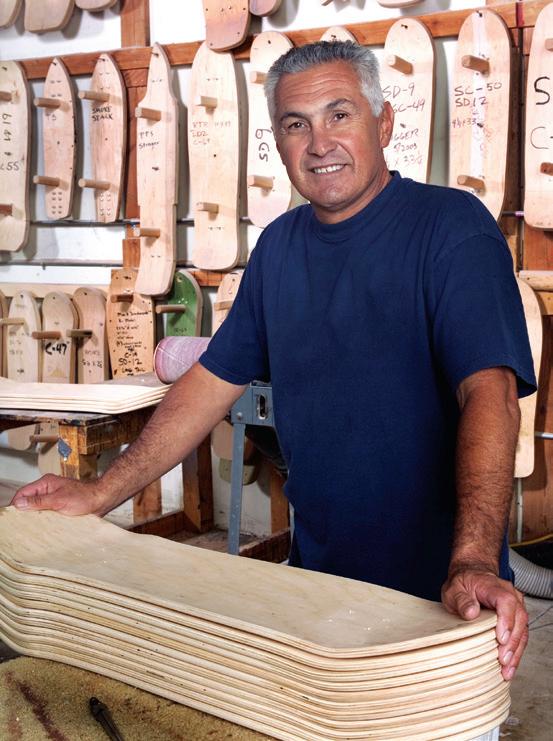
VANS X MADRID SHOE COLLAB
In 1987 Vans and Madrid teamed up to offer Vans’ first collaboration shoe with a skateboard brand, the Madrid Fly shoe. Images of flies covered the side panels of the high-top shoe, and a large rubber toe cap made the shoes a favorite of the Madrid team. In 2016, Vans will reissue a limited run of the Madrid Fly shoes to celebrate its 50th anniversary.
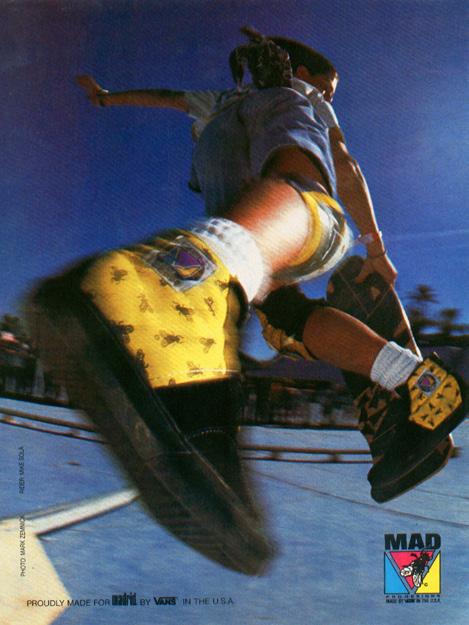
JERRY MADRID VS. GENERAL MOTORS
By 1983, Frank Nasworthy’s original trademark for Cadillac Wheels had lapsed. Jerry began producing Cadillac skate trucks and attempted to trademark the Cadillac name for sporting goods. However, General Motors opposed the trademark; the auto maker had plans to produce a Cadillac SUV that could technically qualify as a “sporting good.” Jerry and his attorney were in a classic David vs. Goliath situation but did not back down from the legal battle. Jerry says GM kept postponing the trademark hearings as long as possible to try to drain him of his legal funds. However, after GM missed a filing deadline to postpone a hearing, Jerry was granted the trademark and the right to make Cadillac skate gear. Cadillac Wheels are still poured in the USA and are stock equipment on the majority of Madrid complete setups.
Jerry Madrid, late 2015: A molder of skating’s past, present and future.
Lee Cation
is a downhill skateboarding event producer living in Vancouver, British Columbia, Canada. You might have seen him on YouTube, scolding the police for using their vehicle to run him and his friends off the road. He specializes in organizing longboard events in British Columbia via his company, Unkle Events. His most wellknown events to date include the annual Whistler Longboard Festival, which just completed its fifth year, and the annual Britannia Classic, which is about to head
into its ninth year. In addition to his work with Unkle Events, Lee is also a cofounder of the nonprofit International Downhill Federation (IDF) and is one of seven members of its board of directors.
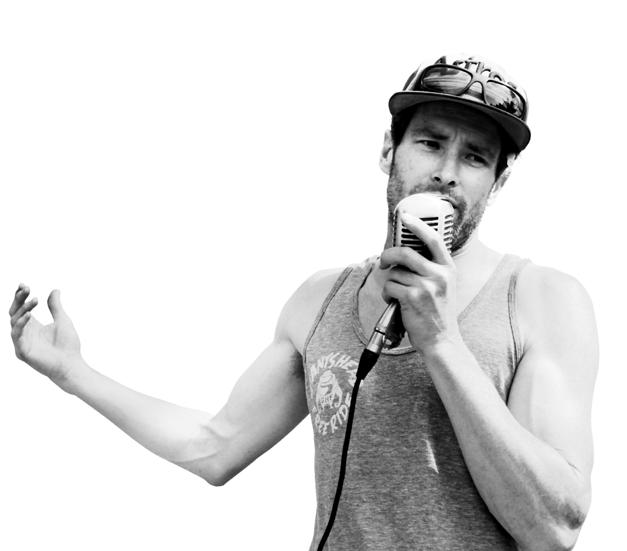
As Lee sees it, hosting events is like hosting a big party and inviting all of your friends. “Your goal is for everyone to have a blast ... and make sure the cops don’t show up!” Lee says. “I was always a host, even in high school. I lived across the road from my secondary school, so I’d have everyone over for a kegger party
and some live music ... during school hours.” Lee has two older brothers and says he was taught the art of hosting early on. “Hosting a downhill event is a little more complex than a party, but I still love getting everyone together for good time.”
Lee grew up in the flatlands of Caledon, Ontario, just north of Toronto, and spent time working on his grandparents’ farm. He had a Tommy Guerrero street deck when he was young and sometimes skated a mini ramp that belonged to a cousin, but otherwise there
58 | CONCRETE WAVE - WINTER 2016
While many of us attend skate events, not many people consider what it’s like to actually be responsible for organizing and running them. We wanted to take you inside the mind of an event producer and explore what it’s like to face the challenge of hosting several hundred skateboarders in all conditions on a mountainside road, year after year.
A PROFILE OF RACE ORGANIZER LEE CATION
wasn’t much to skate in the country. However, “I had a dirt bike and I liked to snowboard. That hasn’t changed,” he says.
After high school, Lee moved about two hours down the highway to London, Ontario, to study the aviation business at the University of Western Ontario. “I was set on working in aviation and started down that path,” he says. “It turned out I didn’t fall in line with the union and found myself back at square one. My buddy was heading out west, and we made a plan to snowboard at the big mountains along the way.”
After making it to Vancouver, Lee says he was hooked by the geography and the climate. He ended up with a landscaping job to pay the bills, and in order to get to the different job sites, he started to borrow his roommate’s longboard. As he got more comfortable, Lee realized that if he carried his speed down the rolling Vancouver hills, he wouldn’t have to push up the other side.
“I started to look into getting my own board and realized some of the best longboards in the world were made in Vancouver by young brands Landyachtz and Rayne,” he says. His first downhill event was Coast Longboarding’s Attack of Danger Bay in 2005, with Bricin “Striker” Lyons on the mic, and he found the vibe infectious.
Lee says his interest in producing events started when he began to host outlaw races in Vancouver. After three or four great urban outlaws, Lee hosted a trial outlaw race in Britannia in 2006 with 10 friends. “I knew it was time for a new style of race, one that was steep and included drifting,” he says. “The next year I did a one-day, legal event.” Over time, Britannia evolved from two days to three days, and then in 2011 after months of meetings, documents and headaches, Lee finally landed Whistler and dove in headfirst on having a two-day event. The Whistler Longboard Festival eventually grew to four days, including a live video
stream, skate-and-shoot biathlon and big-air competition, and then settled back down to three days in 2015.
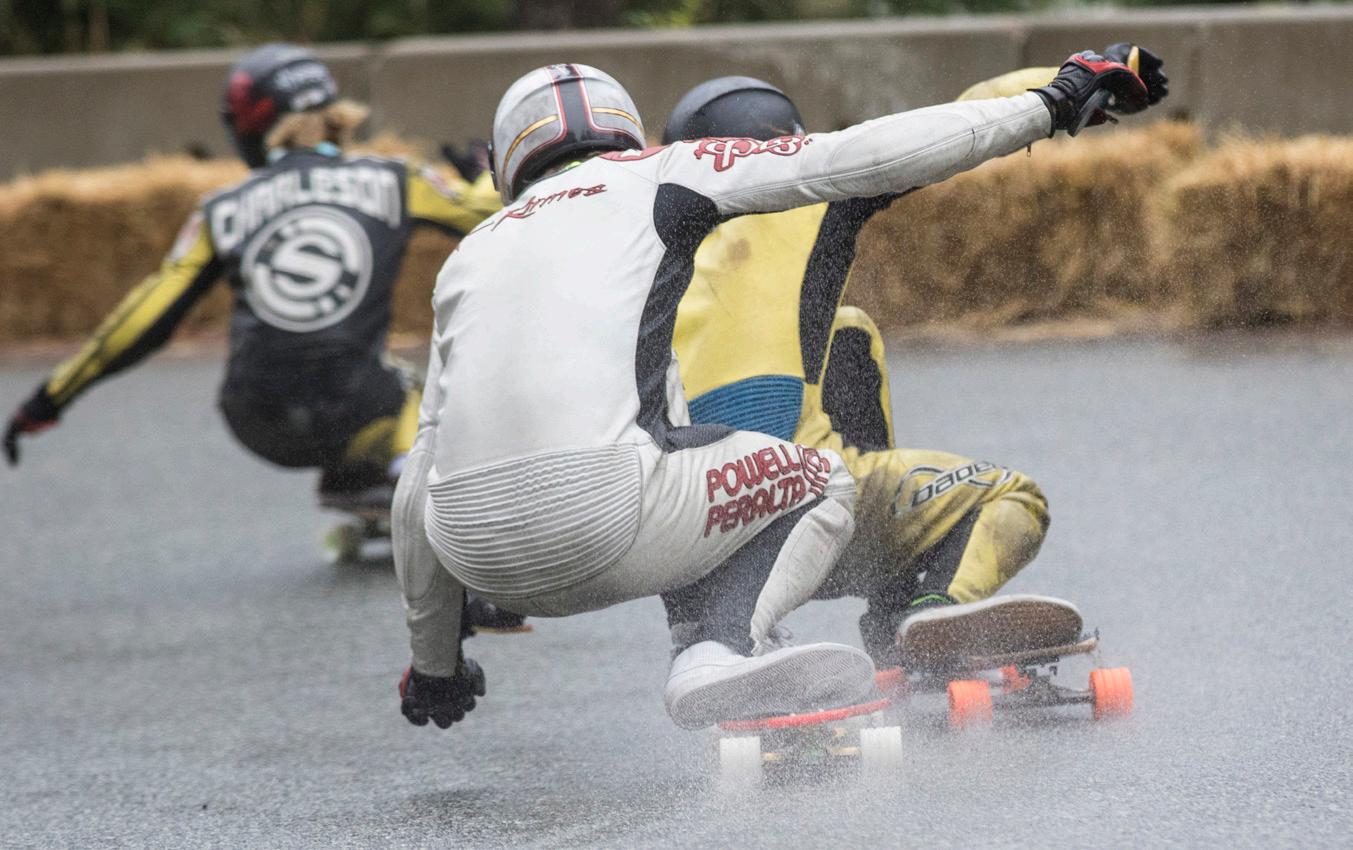
When it comes to handling the pressure of dealing with things, Lee says his age and experience help. “When things are getting tough, I just always remind myself that all a downhill event really needs is a good road, an uplift, some hay bales and great people,” he says. “Everything else is a bonus. When things get tough, I focus on the big picture.”
Lee surrounds himself with people who have skills beyond his own and says none of it would be possible without the help and support of the downhill community. If something’s not working, he’ll readjust and try a different way, ask for some help from others or move on. “Sometimes it helps to move on and come back to the challenge when you have more energy,” he says. “Sometimes it can’t wait and you’ve just got to do your best.” He tries not to get too hung
CONCRETEWAVEMAGAZINE.COM | 59
Lee Cation sweats the details of race organizing so racers like Alex Charleson, Mauritz Armfelt and Kevin Reimer can focus on riding. Whistler Longboard Festival 2015. Photo: Matt McDonald
up if something isn’t going his way. “I enjoy a challenge and work best when the pressure is on, but at the end of the day I’m a big fan of the ‘Pareto Principle’ (the 80/20 rule),” i.e., 80 percent of problems are caused by 20 percent of the work.
Of course, it’s not all roses running an event, and Lee admits that he doesn’t always keep his cool. “Given our status as a ‘fringe activity’ in these tourism regions, we’re often forced into shoulder-season dates (spring/fall), and that can mean wet weather,” he says. “Rain on every day of my three-day event is frustrating. The event still goes on, but the smiles are smaller and the crowds dwindle.” Lee says it’s also really hard to make the event look like fun or to be a great marketing opportunity the following year when the visual media is all rainy and cloudy with little audience.
“We’ve had some wet ones. At the 2014 Britannia Classic we had almost a foot of rain over the three days and we got about half a foot at Whistler this year,” he says. Fortunately for Lee, a lot of the Northern and Northwest DH skaters like wet riding.

When asked what really causes a huge amount of stress, Lee says wet hay bales that are used for barrier protection are a major pain. “Setting up a burly track requires a lot of bales and a lot of manpower!” he says. Whistler requires about 1,000 hay bales, and Burke Mountain, Angie’s Curves and Pikes Peak need closer to 2,000. “Hay and straw absorb moisture like a tissue does, so when it rains your bales pack on the pounds,” he continues. “They can easily get 10 times heavier in rain! Even worse, the moment your hay or straw bales get
wet or damp they become valueless.”
The other nightmare is when technology fails, which happened at Pikes Peak and Whistler 2013. “The IDF was working through some growing pains, and we had timer issues at 12,000 feet above sea level,” Lee says. He and his team had to seed the elimination brackets based on past IDF rankings and, thanks to some understanding and supportive people, the race went on and finished on a high note. “We learned a lot that year, and the timing equipment has become very reliable since,” he says. Still, he notes, “Everyone needs someone to blame, so I stepped forward. It was one of my darkest days. People get pissed when they are let down. I handled it by writing a very open and honest public apology post on the IDF website.”
60 | CONCRETE WAVE - WINTER 2016
Thiago Lessa leads Jordan Perrett into a wet lefty at Whistler. Photo: Matt McDonald
Lee says it’s really important to let all parties know the “why” when things go wrong. He notes that the downhill community is pretty reasonable and everyone understands things once you share the info. As an example he cites the 2013 live stream at Whistler. “It was tough because we were no longer on the riders’ schedule or even the IDF’s schedule; we were on the live stream schedule, and every second counted. We had to make some tough split-second decisions that year, which didn’t please everyone.”
Speaking of Whistler, Lee calls it a bit of a beast. “We went from being one of their ‘Top Ten’ summer events to not getting a summer date at all, and to boot they increased our venue rental rate by 100%. Why? Well, Whistler is built on hotel revenue, and the town cringes a little when they see our tents and RVs roll into town.” Ever since the 2010 Winter Olympics, he says, Whistler has become the “Las Vegas of Mountain Resorts. They have the biggest events in the world there, including the top mountain bike, ski and snowboard, food, beer, music, yoga and adventure-race festivals. The Longboard Festival is pretty far down that list now. The time of year or timing of other festivals can increase your numbers or leave you with no options at all.”
It is tough to balance one of the world’s biggest Olympic resorts with grassroots skating. There are many levels of stakeholders in Whistler, including the

government, the mountain resort and the Whistler Sport Legacies (NFP sport group). “Each [has] to approve our annual plans,” Lee says. “At the Britannia Classic we need to balance the transportation authority, the community association, the health authority, the regional district and the local residents. We worked out a deal back in 2007 at Britannia that allows us to use the road once a year for an event; in exchange we agree not to heat out the hill outside of event hours. There is no security in downhill event planning; every year could be the last, and that uncertainty is a really hard, but an exciting part of what I’ve been doing.”
Despite all the risks and obstacles, Lee has made friends with some amazing people and been lucky to travel to some amazing places, including Europe, South America and South Africa, and he says the feeling of putting on a successful event is truly amazing. “It’s a high like no other. When you bring international riders to your region for the first time and they get to shred your hills and parks, it’s priceless. It’s a very special thing we do, and I wouldn’t change this path one bit.”
Lee says he sometimes loses the stoke when people think he’s hosting events for the wrong reasons. But he regains it by loading up his car with shredders and hitting the hills, saying there is no better way to spend time than to slay some mountains. “Working in a home
office can bring on cabin fever,” he says, “so I look forward to the welcoming Friday 5 p.m. beers at the Landyachtz factory and getting to hang out with others who share the same stoke.”
Lee hints that he’s been working on hosting some less competitive and more inclusive events on some new hills in the future, possibly in spring 2016. Sun Peaks Resort in BC built a new “gravity track” that has the potential to host a great freeride event – like a smaller, more compact Giants Head with a ski lift back to the top. On the other end of the spectrum, Lee says he’s been working on a World Record Speed Invitational and trying to find a non-skate presenting partner. He’s got all necessary approvals for the third year in a row but won’t give it the green light until he lands a lead sponsor. He is even offering a 20% reward for anyone who brings in that big fish.
Finally, although race results can be important, Lee says the real competition these days is “How many runs did you get? How much time was spent skating instead of waiting?” As for the future, he says can’t control it and would rather not try to predict it. “It’s up to the groms to show us where we’re going,” he says. “I’m looking forward to what comes next, and in the meantime I’ll be sampling new locations and dreaming up new events.”
CONCRETEWAVEMAGAZINE.COM | 61
A racer as well as an organizer, Lee focuses forward at the Britannia Classic. Photo: Jim Hegan
“I enjoy a challenge and work best when the pressure is on...”
MAITANE RASCON
Last year I started skating with the new Landyachtz Hatchet board. For slower genres like dancing, it is one of the best boards I have ever ridden. The size is perfect, the little concave makes it more safe for stand-up slides and the generous size of the kicks are perfect for freestyle. If I want to go faster and still freestyle, I pick up my Landyachtz Tomahawk. It’s light, harder concave and no flex. The trucks I use are usually Bear Grizzly Gen 5. Grizzlies work on all terrains; they are tough and do not bend easily. For faster days I use Bear Kodiaks. I use Seismic Bootleg wheels almost in every discipline. I love their shape. The wheels are very good for sliding smoothly and provide me with large standups. I always use Tekton bearings.

62 | CONCRETE WAVE - WINTER 2016
PART 6

CONCRETEWAVEMAGAZINE.COM | 63
This rider setups piece features skaters from Spain, Japan, the Netherlands and the USA.
Photo: Noelia Otegui
AMANE KISHIDA
For me, I love surfing and therefore I want to surf every moment of my life – whether it’s in the water or on the streets. My ideal setup consists of a wheel that I can drive really hard, a loose, turny truck and a ride-everything kind of board. My favorite all-time ride is my Amane Kishida pro model from Kebbek, Surf-Rodz Grind TKP 159 mm trucks and the Magari v2 wheels that I have been working on with Seismic.
 Photo: Masayuki Sano
Photo: Masayuki Sano
ROSANNE STEENEKEN
Currently I’m skating a DB Longboards Keystone 39. The radial concave allows you to have fun with friends during a run and still feel locked in. The Keystone is a board that I can skate and crash without the fear of breaking it because the urethane tips provide unparalleled shock absorption, protecting the core in cases of hard impact and preventing potential delamination. Depending on the road and speed, I use any Cloud Ride wheel because of the smooth slide. I combine those two with stable Ronin trucks and RipTide bushings. And that’s how I roll!
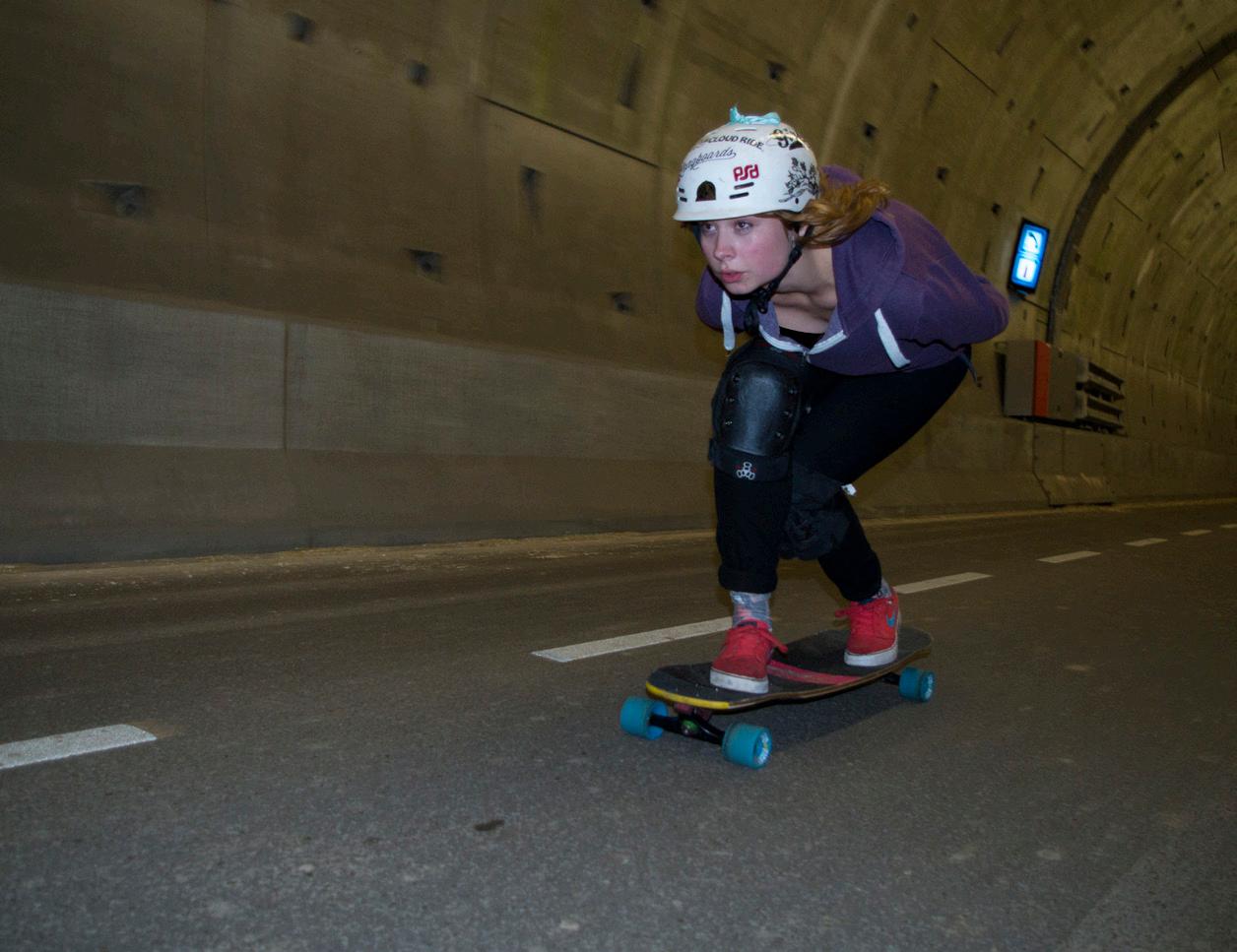
CONCRETEWAVEMAGAZINE.COM | 65
Photo: Ingmar Solissa
JASON MITCHELL
My primary set up is a PPS ATX (All Terrain X) designed by RacerX and Pocket Pistols Skates and handmade in the USA by Deckcrafters. I ride Surf-Rodz 159 Grind TKP trucks because of the performance first and foremost. The craftsmanship is also top of the line. They are amazingly turny and extremely responsive. I use Khiro Hardcore products – risers, bushings and hardware – along with Nitro bearings. These are highquality components that I have come to trust and love for all my setups. For wheels it’s either Seismic Boosters or “Hackett Slash” Chetahs. The Chetahs are my favorite transition/park wheels – cored, fast and great grip.
 Photo: Cameron Bowser
Photo: Cameron Bowser
BRANDON DESJARLAIS
I ride the Moonshine MFG Hooch as my go-to board because of the symmetrical standing platform, kicks in the tail and nose and functional shape. This board is lightweight, waterproof and more durable than anything else on the market, making it a perfect fit for an abusive, allaround rider like myself. Equipped with 180 mm rakeless Liquid Trucks on symmetrical 45-degree plates and 90A/95A RipTide APS tall barrels, my setup has a stable, predictable center with the ability to carve deep and lean into my slides. For wheels I use Abec 11 ErnieZ for fat slides with even fatter thane lines! This is the type of board I feel confident taking through the gnarliest of driveways and alleyways as well as bombing down the tightest roads. I couldn’t be more stoked!
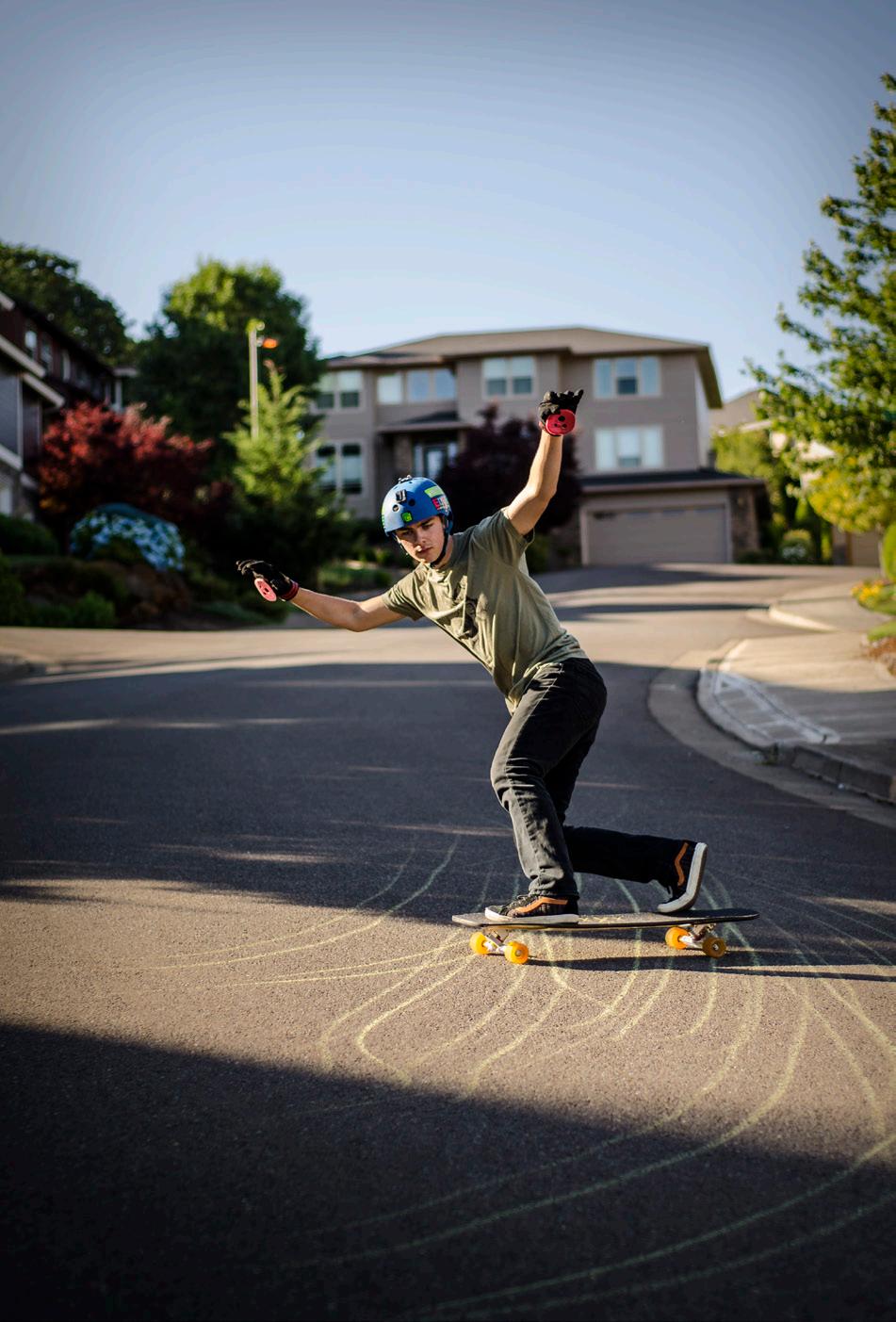
CONCRETEWAVEMAGAZINE.COM | 67
Photo: Daniel Freauf
The Zen of Freestyle, 3


These days, it’s easy to get worn down by the effects of our modern lifestyle: traffic jams, pollution, fast-food diets, social media overload, the reality of “reality TV.” It’s only natural, then, that we search for a means of escape. For some, it’s getting lost in the pages of a good book; for others it’s simply getting away from it all.
A growing number of skateboarders have found a different solution. It’s called freestyle – and these riders say the Zen-like peace they find when doing it not only calms the mind but stimulates the senses and rejuvenates the soul. Here then is part three of The Zen of Freestyle, which we hope will enlighten you to the joys and rewards of freestyle skating.
Interviews by Monty Little
Mic lives in the metropolis of Tokyo, which is also the home of a thriving freestyle community. Besides being an accomplished makeup artist, she is also the top-ranked female freestyle skater in the world and a member of the PowellPeralta freestyle team..


Monty: With only a few hundred freestyle skateboarders worldwide, being a female skater in a prominently male sport is even more of an anomaly. What drew you to skateboarding, and in particular to freestyle?
Mic: I had taken up snowboarding and was looking for a way to practice in the summer, so I started skateboarding. In fact, I bought my first skateboard as a birthday present to myself. Because it was totally new to me, I turned to the Internet to find out how and where to skate. While watching some YouTube videos I came across one on freestyle. I couldn’t believe what I was seeing. I thought, “I want to do that,” and I have been doing it ever since.
Did learning freestyle come easy? No, not at all. In fact, I fell and hurt myself many times and even broke both of my knees when I was just learning. That accident made me very cautious, which I think held me back. Any freestyle skater will tell you the same thing; you’ve really got to want it bad. You have to pick yourself up time and time again after you trip or fall when practicing a new trick. Being a freestyle skater is all about dedication.
How often do you get out and skate? I get out at least twice a week, and usually hang out at the Shin-Yokohama Skatepark, which is my favorite place to skate. It has a large, smooth area that is ideal for freestyle, and because it’s under an overpass we can skate rain or shine.
Well, all that practicing definitely paid off, as you have consistently placed in the top 10 in the amateur division at the World Round-Up. What is it like to be the only girl competing in a division made up of guys?
One of the things that is so special about freestyle is that we are part of this big extended family. That’s why when we get together to skate for fun or at a contest, it’s like I am skating with my brothers. They are always looking after me and helping me to learn new tricks.
Are there many female freestyle skaters in Japan?
There are a few – not sure how many, but I hope that through my example I will be able to encourage other girls, not only in Japan but throughout the world, to get involved in freestyle.
I understand that there is a large freestyle community in Japan. Tell us a bit about it.
You’ve seen firsthand how many Japanese skaters come to Canada each year to compete. Well, at this year’s All Japan Freestyle Championship there were over 40 contestants, of which six were girls. The Fujii brothers, Masahiro and Toshiaki, help to run the event and have really helped to give the sport a boost.
 Mic Murayama
Japan
No-hand pogo to primo. Photo: 49n
Mic Murayama. Photo: 49n
Mic Murayama
Japan
No-hand pogo to primo. Photo: 49n
Mic Murayama. Photo: 49n
Recently I saw a YouTube video of you skating in Brazil. Tell us about your visit.
I had a wonderful vacation visiting my family in São Paulo and got to skate with lots of my freestyle friends at Ibirapuera Park. This park is huge, totally undercover and has a flawless concrete surface to skate on. While I was there I met up and skated with Per Canguru, who set the world record back in July for the longest coconut wheelie.
What is it about freestyle that is so special for you?

It’s a way of expressing myself, and although learning each trick has been difficult, taking hours and hours of practice, when I finally felt comfortable doing end-overs, G-turns and difficult footwork tricks, the satisfaction I received brought me inner peace.
I know that George Powell asked you to join their team. What was that like?
To be able to meet George Powell was a big thrill, but when Takashi Suzuki and myself found out that he wanted us to skate for Powell-Peralta, we were both blown away and very honored to be chosen for the team. You see, in Japan only the elite skaters receive recognition, so being sponsored by Powell-Peralta says a lot about how far I have come and my skating abilities.
Do you have any other hobbies?
When I’m not doing freestyle I like to just cruise around on my skateboard. I also love surfing, yoga, cooking, and playing with my kendama.

Is “kendama” your pet?
(laughing): No, Monty, it’s a Japanese wooden toy used for hand-eye
coordination – sort of like juggling, but doing yo-yo tricks and dancing all at the same time.
OK, well before I confirm that I am totally out of the loop, I want to thank you for sharing your story. I know it is going to inspire other girls.
Author’s note: After our interview I went on Google to find out what a kendama was all about. I came across a YouTube video called “World’s Most Amazing Kendama Ninjas.” Be sure to check it out.
No-hand 50-50 Casper. Hair and Makeup by Sachiko Takita.
Photo: Sawako Fujii
Ryan Brynelson
Age 24, Canada
Although Ryan hails from Delta, British Columbia, he is currently living in Yokohama, Japan, where he works part time at a Japanese language college helping foreigners learn Japanese. (He graduated from this same language school.) The top-ranked amateur freestyler in the world, he decided to turn pro in 2014, placing first at the All Japan Freestyle Championships, and finishing in the top 10 at the World Round-Up later that year.

Monty: “Ohio.”
Ryan (laughing): Very good, Monty! Good morning to you too. Didn’t realize you knew any Japanese.
Only a handful of words. How hard was it for you to learn the language?
It’s definitely a language that takes time. However, being in Vancouver I had more opportunities to speak Japanese than French, so I think because of my environment I was able to learn it at a faster rate. Of course, moving to Japan and living here for almost two years has helped a lot.
I’ve watched your progression and love of freestyle grow over the years, but when did you first get started?

I got into skateboarding when I was about 8, but started practicing more seriously when I was 14. It was a year later [when] I got invited to a BBQ at Kevin Harris’ place that I first encountered freestyle, and from that point on I was hooked.
I remember that day. Your aunt Cathy asked me if her nephew, who was into skateboarding, could come to the annual “Skaters’ BBQ” that Kevin and I put on. Kevin saw the potential in you and sort of took you under his wing.
Kevin has definitely been my mentor and good friend, spending so many hours helping me learn tricks that I have lost track. He has this large concrete freestyle area in his backyard, so I would go out to his place any time I could and practice with him.
Was learning freestyle easy for you?
It definitely was not. I remember spending almost every day after school practicing for hours in the beginning. That was almost nine years ago, and to this day I have been skating about four days a week nonstop. It’s definitely become a routine, much like eating or brushing your teeth. I also took a bad fall that resulted in two serious compound fractures to my left arm that took three surgeries to correct. For whatever reason though, that accident was the spark that ignited the fire giving me the desire to stop just putting around on my board and start taking skating more seriously.
What is it about freestyle that turns you on?
It’s a style of skateboarding that is just so creative. With freestyle there was never any pressure to learn a particular trick. Spins however, are my favorite trick without a doubt. When I am spinning, it just feels so natural and turns all my problems into a blur.
Freestyle is usually considered to be an individual sport. What’s your view on that?
I never really did feel connected to the skate community 100%, to be honest. For many people skating is skating with your friends at the park. For me skating is something done alone and used as a test against myself.
Cruising a nose wheelie at Vancouver’s Stanley Park. Photo: Jim Goodrich
Where do you like to skate?
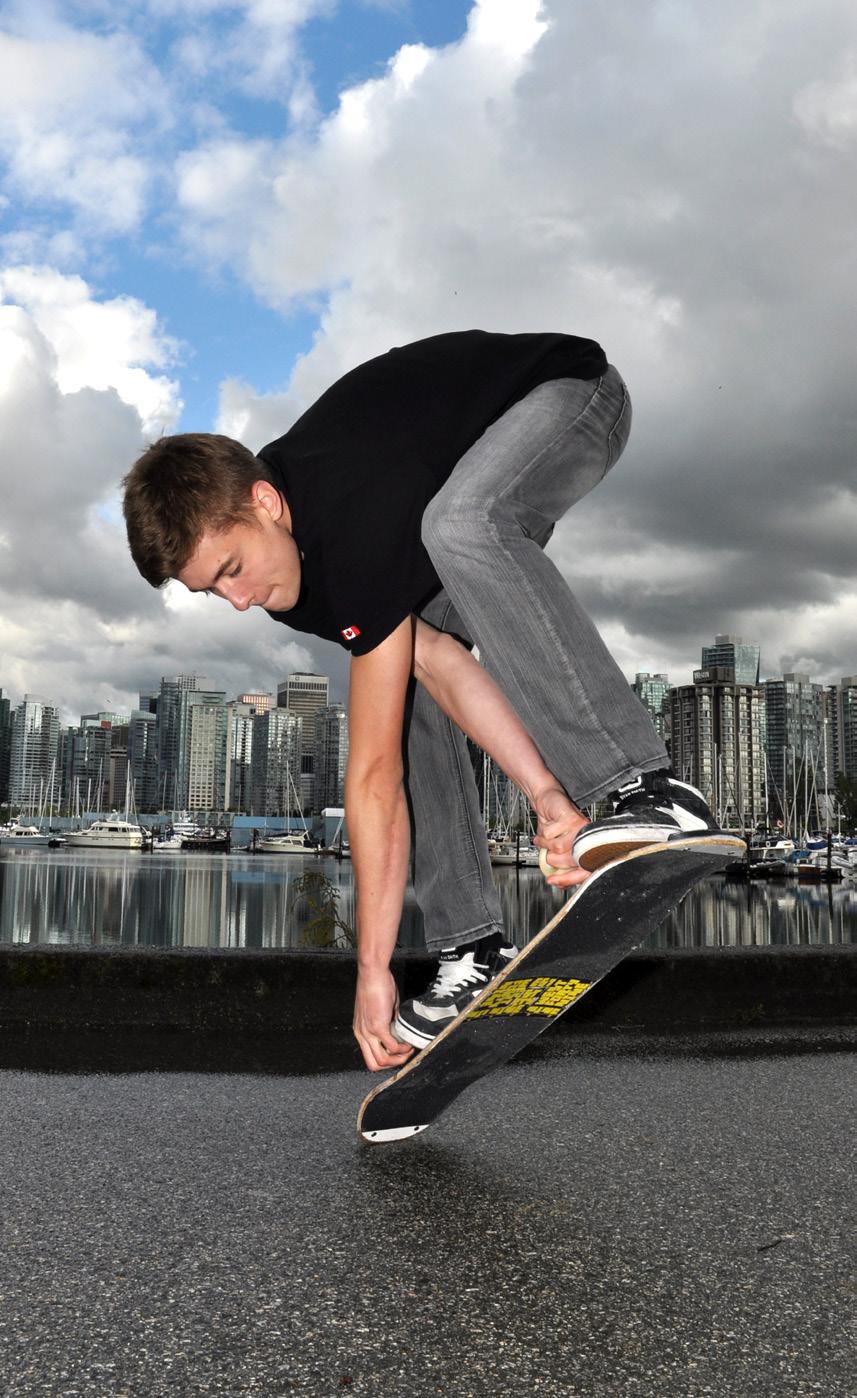
My favorite place here in Japan is a skatepark in Yokohama. There’s another skatepark near the American military base here that is really nice, too. It’s right on the beach with an awesome view of this uninhabited island.
Was it a bit of a cultural shock, moving to the huge city of Yokohama?

Not really. I had been studying Japanese and hanging out with a lot of Japanese people for years. I kind of felt like I had half the culture shock experience out of the way compared to some of my friends who didn’t start studying Japanese until they got here. The realization that I was not in Kansas anymore came when I couldn’t just jump on a bus and arrive a half hour later in Cloverdale at the World Round-Up. Since I was a student, trying to find an extra $1,200 for the airline ticket to Vancouver … well, it just wasn’t in the cards. Lucky for me my skateboard sponsor, Hippie Mike of Protest Skateboards, helped me get to the contest in 2014.
You know Ryan, you are part of the reason that there is a World Round- Up. Back in 2011 you, Kevin Harris and Kai Dunkel were putting on freestyle demos at the Cloverdale Rodeo & Country Fair. Kevin knew I lived only a few blocks away, so he gave me a call and asked me to walk down and see your show. It had been years since I had been involved with skateboarding, but when I saw the crowd’s response to you three and to freestyle I knew I had to come out of retirement. Well, I for one am glad that you did, for the World Round-Up is now the freestyle contest to be at. The talented skaters it draws from all over the world is one of the reasons we all keep coming back. In fact, I’m moving back to Canada in May, so I will see you at the contest.
Cross-armed Sidewinder. Photo: Jim Goodrich
LONGBOARDING FOR PEACE


GIFT CARDS AND SKATEBOARDS FOR GUNS
 By Harvey Hawks Photos: Meredith Estel
By Harvey Hawks Photos: Meredith Estel

On Dec. 19, 2015, Longboarding for Peace, in conjunction with the United African American Ministerial Action Council, Off the Street Youth Diversion Program, elected officials and law enforcement, participated in San Diego’s seventh annual “gift cards and skateboards for guns” exchange. In exchange for an unwanted firearm, participants received a high-quality skateboard or a gift card valued at $100 for rifles, shotguns and handguns and $200 for assault weapons—no questions asked. Law enforcement agencies and private citizens donated $20,000 for gift cards, and skateboard companies including Carver, Loaded, Orangatang, Bustin, Flying Aces and Primitivo donated an abundance of skateboard parts to make available nearly 200 skateboards and longboards for the event. Carver Skateboards graciously offered to assemble the donated parts into complete setups, equipping every board with Carver trucks, and donated more than 100 beautifully crafted Carver completes for the event. The gates at the Bryco Building had to be opened early due to the

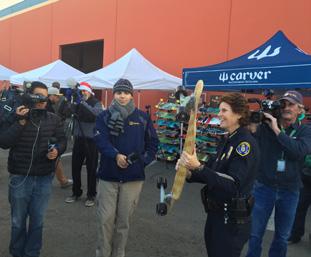
large number of people showing up. The collection continued until just after noon, netting some 242 pistols, rifles, shotguns and assault rifles. People of all ages and walks of life turned in firearms for gift cards and skateboards; the majority of them exclaimed their happiness at receiving a high-end skateboard to give as a Christmas gift. Of particular interest this year were a number of young fathers who had made the decision to remove the potential threat of firearms from their homes in exchange for skateboards for their young children.
The overall feeling and sentiment of those who participated in and organized the event was hope for a peaceful future, knowing that each weapon removed for the streets reduces the cycle of gun violence that plagues our society. This was the second year that Longboarding for Peace participated in the San Diego gun exchange. Another event is being planned for early 2016 in the greater Los Angeles area.
EAST COAST CUSTOMS & SHARE THE STOKE
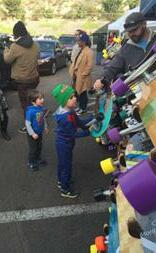
This past October, East Coast Customs partnered with Share the Stoke Foundation to stoke out some kids in Portugal. This non-profit normally travels the world setting up surf programs for kids who can’t afford boards but need a positive outlook and way to express themselves. On this last trip, however they decided to take it to the concrete and give these surfers a way to play outside of the water. The pavement was the perfect place to practice those turns on a skateboard. A huge thanks to East Coast Customs for donating to these kids halfway around the world! For more info visit ecclongboards.com and sharethestokefoundation.org.

POWER TO THE PEOPLE
People skateboard for many different reasons. Some enjoy the freedom and some enjoy the exercise – both physical and mental. But for more than 50 years, skaters have challenged the idea that you could only push with your own power. Gasoline-powered skateboards were available as far back as 1965, and back in the 1970s, Canadian skate legend Willi Winkels would bring out his gas-powered Motoboard and drive crowds wild. Unfortunately, due to its extremely loud noise and pollution, the Motoboard was eventually banned in California.
Electric skateboards were a later development. The first ones started to make their way onto trade-show floors and under skaters’ feet sometime around 1997. We can thank a man named Louis J. Finkle for his pioneering work to make that happen. “Electric Louie’s” boards definitely had speed, but they were bulky (some weighed more than 80 pounds) and expensive (when adjusted for inflation, about $2,000). A company called Altered Skates took over from Louie and managed to move things forward. They cut the weight to 42 pounds and achieved quite a bit of success. (Longtime readers may remember that Altered advertised in Concrete Wave back in the mid-2000s.)


The last three years have brought electric skateboards to a whole new level. Breakthroughs in battery technology have reduced board weights dramatically, with many setups weighing 15 pounds or less, and sophisticated software and motor controllers allow riders to customize the boards’ power, speed and range.
Legal barriers are falling, too. On Oct. 11, 2015, Governor Jerry Brown of California signed a bill that made electric skateboards legal – a boon to electric enthusiasts.
As retailers across North America report brisk sales, we wanted to give our readers a little more insight to this world.
While we profess a devotion to pushing, riding an electric skateboard can also be quite a joyful experience. Their speed, portability and quasi-hoverboard sensation make for a pretty cool ride. As people look for ways to deal with the madness of traffic congestion, electric skateboards offer a truly alternative means of transportation. Remember this statistic: 50% of all car trips in the USA are less than five miles. Why drive when you can glide?
ELECTRI C S K A T EBOARDS FIND T H E I R NICHE
74 | CONCRETE WAVE - WINTER 2016
Based in Mountain View, California, Boosted Boards entered the market in 2012 with a lightweight, extremely sleek design. Their unique approach earned them almost $500,000 on Kickstarter along with a TED Talk.
I met up with Matthew Tran, one of Boosted’s three co-founders, at last September’s Surf Expo to find out more about the company.
All three co-founders attended grad school in engineering at Stanford, and they all sometimes skipped class for an epic powder day on the slopes. “We are engineers by background, with a passion for all things fast, and a little on the edge,” Matthew said. “It makes sense that we would work on a fast, fun electric vehicle to bring the feeling of the slopes back to our daily commute.
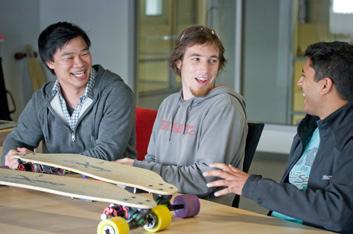
“I would describe myself as a daydreamer with sketchbooks full of hoverboards and airplanes,” he added. “When I heard that a Segway felt like a flying carpet, I knew I had to recreate this sensation on a board.”
John Ulmen built the first Boosted prototype to speed up his trips around campus. Matt described John as one of those brilliant scientists who had to be carefully watched as a child: “You know, the kind that turns the family Christmas tree into a rocket and launches it.”
Matt called Boosted’s third co-founder, Sanjay Dastoor, a curator of technology. “He can talk for hours about the advantages of air-cooled Porsches or the virtues of the original Sony Walkman,” he added. Sanjay is gregarious by nature, Matt said, so he knows a lot of people, and he was the one who connected John and Matt.
The team used John’s prototype as the basis to launch Boosted. They went through many iterations of intense testing and direct user feedback, relying on what Matt called “irrational optimism” that they were on the right track. “Otherwise, we would have never left our day jobs,” he said. “When people started running after us to ask where they could buy a prototype and grown men giggled after riding it, we knew

we were on to something big.” Others have also contributed to the company’s growth. Mark Frykman was Boosted’s first intern. “He’s a surfer at heart and lives in the machine shop when he’s not in the waves,” Matt said, “so he was a natural to be in charge of our mechanical design.”
George Schnakenberg grew up skateboarding and now commutes around San Francisco on electric bikes he designed and built. “As our industrial designer, George did an amazing job of making the Boosted board tough and beautiful,” Matt said.
Electrical engineer Jean-Francois Duval helped Boosted design their circuit boards. For personal and professional reasons, he left for MIT, so Jessica Riley later joined Boosted as the electrical engineer. “She is not only a great engineer but has also helped to organize the increasingly complex design” Matt said.
The final person on the original Boosted team was Sal Trujillo. “He’s an extremely diligent designer,” Matt said, “a brilliant software engineer who made the board feel so natural and intuitive.”
Boosted currently offers three models. They vary in price from about $1,000 to $1,500. Depending on the model, speeds can range from 18 to 22 mph. Look for a demo clinic coming to a city near you. boostedboards.com

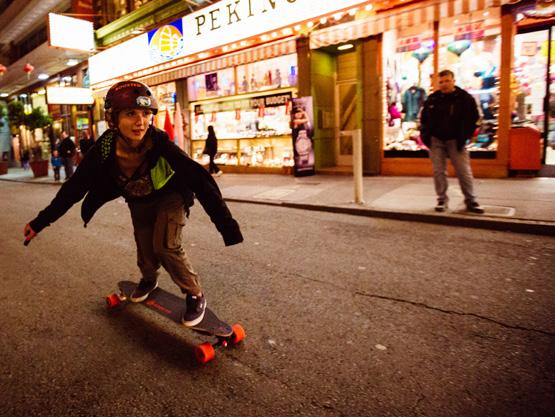
CONCRETEWAVEMAGAZINE.COM | 75
One of Boosted Boards’ most popular models featuring dual motors.
Boosted founders Matthew Tran, John Ulmen, and Jay Dastoor.
Based in Santa Cruz, Inboard has developed an electric skateboard that definitely looks and feels like a regular longboard. Its beautifully stealth design also incorporates what Inboard calls “Manta Drive,” an in-wheel, directdrive motor assembly.

Product designer Paige Doolin said Inboard knew that if they wanted to make the M1 model stand out from other electric skateboards, they had to do their best to conceal all the electronics. “One of our primary goals with the M1 was to create an electric skateboard that stayed true to its non-electric counterparts, not only in terms of appearance, but performance as well,” she said.
The Manta Drive embeds the motor inside the wheels, eliminating the need to mount an external motor to the deck. “This was a huge step forward for the look of the M1,” Paige said, “while at the same time allowing us to realize our goal of a reduced-friction drivetrain, so the rider can manually push the board without resistance.” From there the team began to figure out ways to integrate the motor controllers, Power Shift Battery and LEDs directly into the board. The result is a truly sleek design.
The company went through at least five different iterations on the deck. “With each new design,” Paige said, “we were


making changes for battery depth, electronics placement and the potential for wheelbite.”
Another critical goal in the design process was transitioning curves and surfaces between the deck’s nose, midsection and tail. “We had to leave enough depth for the battery and other internal components, but wanted to keep the rails and belly slim to give the board a very sleek and lightweight appearance,” said Nate Appel, Inboard’s head of marketing.
The Inboard team spent a great deal of time on computers, working on different models, trying to dial in the correct look, but they also simply rode the prototypes. “We found that getting out and riding the decks answered a lot of questions that couldn’t be determined from the computer,” Nate said. The combined design and testing allowed for educated adjustments that improved the blending of all the deck surfaces.
Inboard’s M1 model has a top speed of 24 mph and can go up to 10 miles on a charge. However, the batteries are swappable, which means you won’t have to wait to recharge – as long as you remember to bring them! inboardskate.com
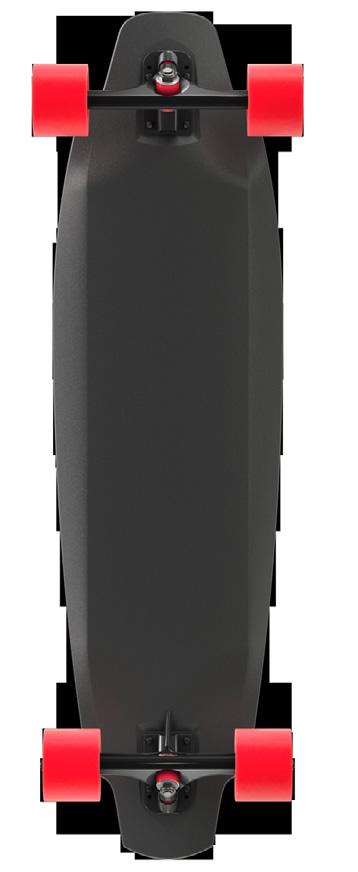
76 | CONCRETE WAVE - WINTER 2016
Enjoying a coastal cruise. Photo courtesy of Inboard.
The Inboard M1 cleverly conceals its electronics with a sleek exterior.
OTHER BOARDS OF NOTE

EVOLVE
Based in Australia, Evolve has spent more than five years in research and development. The boards feature regenerative braking and fast recharge and come in two distinct series: bamboo and carbon. Top speed is 24 mph. The bamboo model has a range of 19 miles, while the carbon model can hit 25 miles. Weight on the bamboo series is 17 lbs., and the carbon series adds an additional pound. evolveskateboards.com
MARBEL
Coming in at just 10 lbs., the Marbel electric skateboard has a range of up to 16 miles and can hit up to 25 mph. The sleek carbon fiber composite deck adds to its overall appeal. Marbel has also created a smartphone app that customizes the ride experience.

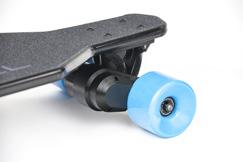

ridemarbel.com
MELLOW
Based in Hamburg, Germany, Mellow raised over $330,000 on Kickstarter by offering a very different take on mobility: the first mountable drive that turns any normal skateboard into an electric skateboard. The Mellow Drive has a top speed of 24 miles per hour and a range of 9 miles. mellowboards.com

METROBOARD
Thirteen years ago, Metroboard founder Ilan Sabar was fascinated by an electric board he spotted. He believed he could improve upon the design, so he started tinkering with ideas. By 2007 the first Metroboard was sold. Metroboard’s current lineup features 3000-watt (peak) motors, a slim battery pack that provides up to a 40-mile range and a wireless infrared remote that is immune to RF interference like Bluetooth and power lines. The boards also feature lights at both the tail and nose. metro-board.com
NGV
Hailing from Slovenia, Next Generation Vehicles (NGV) was established with the idea of developing new-generation vehicles with electric drive. NGV is focusing on one key thing: speed! In late October 2015, Mischo Erban rode an NGV board to a world speed record, averaging just under 60 mph – on flat ground! The company plans to have commercial boards available for sale this spring. nextboards.com
ZBOARD
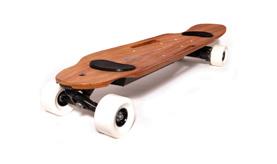
Taking a completely different approach, ZBoard built the world’s first weight-sensing electric skateboard: You simply lean forward to go and lean back to stop. The integrated weight-sensing footpads and electric motor allow you to control acceleration up to a top speed of 20 mph. The 2 Blue model (16 lbs.) has a range of 16 miles, while the 2 Pearl (18 lbs.) can go up to 24 miles. Both models feature unique LED lights on the nose and tail. zboardshop.com
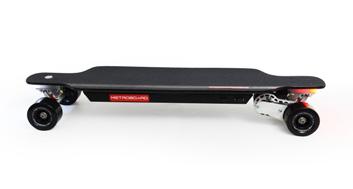
ber that does not flex at all and brings it to market in its new Duralite baseplate. Since Tracker’s competitors push aluminum baseplates so hard in their ads, Tracker can’t convince consumers that the Duralite baseplate doesn’t flex, so they’re forced to mothball it by 1991.
1990 • As the best-selling truck of all time, Tracker is still perched on top of the skateboard world. Producing 60,000 trucks per month, Tracker is so successful, they decide to launch a completely new model called the Tracker Quicktrack. The hollowed out look of the Quicktrack hanger is dramatically different from all previous Trackers.
AN EXCERPT FROM THE BOOK
Tracker - Forty Years of Skateboard History




PART 2 OF 2
• Roger Hickey makes the Guinness Book of World Records for downhill speed runs that consist of 75.3 mph on a luge and 55.4 mph stand up.
1991 • A batch of 30,000 Quicktracks are falsely certified as heat-treated by a heat-treating company and distributed around the world. Many of the hangers break, inspiring skaters to call the truck the Quickcrack. Tracker also suffers another financial crisis that sets back the brand for several years to come.

• Tracker bounces back with the Aggro Street Track, a lighter, stronger, refined version of the Quicktrack.
• After sponsoring the greatest street skater of all time, Mark Gonzales, Tracker experiences a missed opportunity by declining to let him design a new street truck.
Despite this, Tracker goes on to sponsor other top street skaters of the ’90s, including Jeremy Klein, Dan Rogers, Ron Chatman, Laban Pheidias, Willy Santos and many more.
1992 • Debuting in 1992, the Tracker B52 employs the original geometry of the classic Gnarly Tracker base, but lowers it 1/4” for street skating, which is overtak-
OPPOSITE PAGE, TOP TO BOTTOM: Tracker






Rockit Skateboards, the first-ever stiff
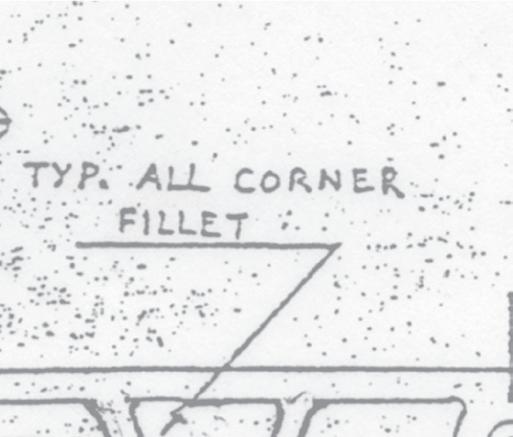
“
Jim Goodrich
”
The inventor of the Ollie, Alan Gelfand, pops one during a night session at Solid Surf skatepark in Clearwater, Florida, March 1979.
unveils
laminated skateboard decks, 1976.
Dave Dominy speed carves his way around the Escondido Reservoir in California, 1975.
Patrick Melcher takes on a huge hubba in Vilinus, Lithuania, 2007.
Tracker invented the game that all other skateboard trucks play in.—GSD
ing vert in popularity. The kingpin is also shortened 1/4” along with the outer cushion, which allows more kingpin clearance while using the lower Extrack hanger geometry. This makes for an ultra-low roll center truck that works, but only because the wheels have become so small and cushions so hard that they increase the board’s flip potential without any wheel bite. The B52 is also the first Tracker baseplate to change to the shortened four-hole mounting pattern that is sweeping through skateboarding like wildfire.
1993 • Tracker markets the B52 Floater and B52 E-Clip Floater, the first-ever floating axle truck and first-ever E-Clips to replace axle locknuts. Because they are so different, E-Clips fail to catch on in the marketplace.







1995 • Four years after suffering a drastic financial crash, Tracker unveils the B2, which is their ticket out of the hole. Although the Tracker B2 baseplate looks almost identical to the classic Tracker baseplate, it incorporates an additional five-degree turning angle that originated with the Aggro baseplate. Although the B2 is great for street skating, over half of its sales are comprised of the 149 mm width, which are destined for use on Gravity and Sector 9 longboards.


1996 • Tracker introduces the Hawk Truk, the first-ever pro model skateboard truck, which sells well until Tony leaves in 1999 to ride his own brand of truck.


1999 • Tracker introduces the Dart, an evolution of the B2, which makes it an all-terrain truck. Street? Vert? Downhill? Longboards? The Dart covers it all. Sporting the same geometry as the B2, the Dart’s baseplate incorporates a wider blocked-out nose and cushion boss that
 Lance Smith
Erick Chezlac
Lance Smith
Erick Chezlac
• Tracker introduces a quicker geometry truck with a steering angle and roll center comparable to Independent. Dubbed the Axis, it is the first Tracker to utilize the Chicago roller skate truck geometry, which Bennett and Independent had copied.

• Tracker introduces the first production Racetrack, reminiscent of the hand-built trucks Larry Balma flowed to slalom racers back in 1976. The Racetrack combines the action of the Haftrack with the width of the Fultrack.


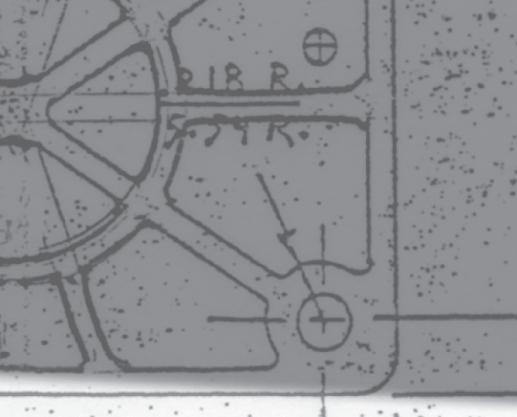




• Tracker introduces its first reverse kingpin truck, the Fastrack, for slalom and downhill.

• Tracker is honored to celebrate its 40th anniversary with an Icon Award from the International Association of Skateboard Companies in the Skateboarding Hall of Fame. The Icon Awards celebrate industry pioneers and cultural icons who have left a permanent imprint on the history and culture of skateboarding.

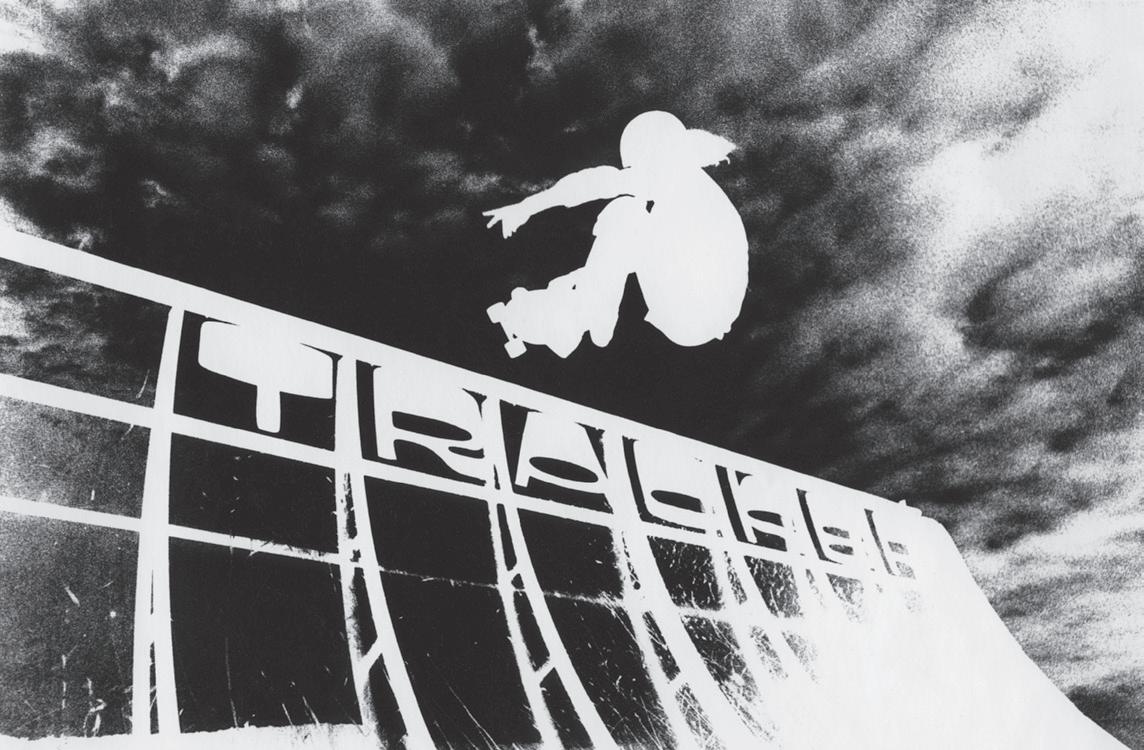

We here at Tracker would like to say thank you to all of our team riders over the past 40 years for being our best friends, and for offering their valuable design input and promotional abilities. Thanks also to all of our employees, who shared their lives with Tracker and worked so hard to make it successful, and to all of the photojournalists who helped promote Tracker along the way. Last but not least, a special thanks goes out to every skateboarder who laid down hard cash to ride Trackers and support the growth of our company, which would not otherwise have been possible.
—Larry Balma and GSD







 Grant Brittain
Lance Smith
The inventor of the frontside air, Tony Alva, pops one off of the Tracker ramp under heavy skies, circa 1978.
BELOW: Larry Balma employs the sledgehammer stress test on a Tracker Street Track truck, 1992. OPPOSITE PAGE, CLOCKWISE: Vert master Lester Kasai launches skyward, late 1980s. Rob Dyrdek tackles a long rail, early 1990s. Per Welinder brushes up on his freestyle in San Francisco, California, 1983.
Grant Brittain
Lance Smith
The inventor of the frontside air, Tony Alva, pops one off of the Tracker ramp under heavy skies, circa 1978.
BELOW: Larry Balma employs the sledgehammer stress test on a Tracker Street Track truck, 1992. OPPOSITE PAGE, CLOCKWISE: Vert master Lester Kasai launches skyward, late 1980s. Rob Dyrdek tackles a long rail, early 1990s. Per Welinder brushes up on his freestyle in San Francisco, California, 1983.
“ ”
“ ”









The invention of the Tracker Truck was one of those pivotal moments in skateboarding when we could suddenly see that there was going to be a future for us as skateboarders.—Stacy

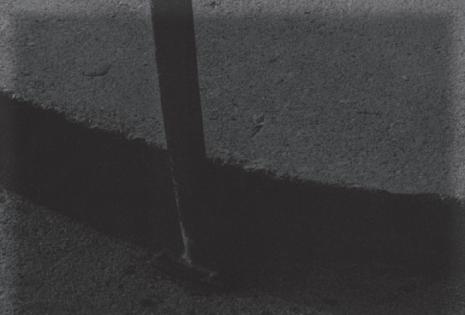



 Peralta
Peralta












Harms
Grant Brittain
 Connor Smith. Photo: Tom Ballinger
By Keith Gillogly
Connor Smith. Photo: Tom Ballinger
By Keith Gillogly
LONG-TREK TRIPS
Skating through countries and foreign lands, spending weeks or even months on the road, has become a proving ground for countless skaters. So if you’re planning a long trek, take some pointers from those who’ve done it before. A combination of grit and knowing what to expect will help ensure you reach that faraway destination, even when it’s a long road ahead.

When facing such a trek, what should you bring? The essentials resemble a camping list, especially for Darrian Balongie. Balongie skated 3,700 miles across the U.S. from New York City to San Diego during the summer of 2013. To honor a young cousin who passed away from leukemia before his first birthday, Balongie made the trek to raise money for St. Jude Children’s Research Hospital in Memphis, Tennessee, where his cousin had received care.
While it’s a weighty requirement, bring a sizeable water bottle. Balongie carried a

four-liter bottle that at times still left him dry. In the desert in Arizona, where the sun’s rays beat down with 103 degrees of fury, Balongie faced a long uphill climb. Lacking water, he knew he wouldn’t make the ascent. He posted up by the side of the road, leaning on a guardrail, waiting for someone, anyone, to pass by. Eventually, a car stopped and someone gave him some sparkling water. “It was like the best thing I’ve ever drank, and I hate sparkling water,” Balongie says.
After being worn out from all the skating, bring a tent that’s lightweight and simple to construct and take down. You can plan stops at some campsites, but if not, you can do what Balongie did: simply veer off the road and camp in a wooded or otherwise suitable area for the night.
Balongie once woke to a coyote around his tent, and Jack Courtenay, who skated north to south across Japan in the summer of 2013, once heard a wolf howling near his tent. So stay aware in
CONCRETEWAVEMAGAZINE.COM | 83
Defining longboarding’s purpose isn’t easy. Some will say it’s a tool for fun, for thrills, for commuting. Or perhaps it’s a vehicle for pushing one’s boundaries and even finding one’s self atop the humble plank and four wheels. All are legitimate purposes, though, and their pursuit produces a common byproduct: exploration.
remote areas, and make sure you can make a quick fold-and-go with the tent. Courtenay’s trek across Japan raised money for children left orphaned by the country’s massive 2011 tsunami disaster. A native of Auckland, New Zealand, it was his first time to Japan. “It just seemed a lot better than coming to Japan as a typical tourist,” Courtenay says.
Beyond practicalities, consider what will be useful particularly for your needs; think outside of that camping list.
Balongie carried a dry bag for electronics, and Courtenay had a translator device to navigate the Japanese language. Courtenay also carried a letter in Japanese explaining his journey’s purpose and fundraising – a token that, when read by strangers, often earned him their support and even free meals or a chance to rest up at their homes.
Balongie carried a Kala U-bass, a ukulelesized acoustic bass that was lightweight and perfect for passing the time on long, flat roads. When tired, he’d even sit on gas-station curbs and play for pocket change. Was it an essential item?
Probably not. But there’s value in any item that helps you keep motivated, stay sane and have fun.
Physical conditioning is also important, and preparing your body for a longdistance skate requires a bit more than that 30-second stretch session you usually forgo anyway. A month before his departure, Courtenay started hitting the gym, and he’d skate to a nearby city and back for practice. Balongie would skate 30 miles a day to prep. Yet even with conditioning, if you’re taking a backpack, it’ll likely prove the biggest burden. Courtenay says that at the end of his first day, he couldn’t even shoulder the weight of his backpack, but that his body soon adjusted. Balongie also had a load on his back. “Had I not had a backpack on, I probably wouldn’t have been sore at all.” That said, you’re probably not used to skating with a heavy backpack, so fill it up now and get those shoulders prepared.
Travel agents don’t specialize in crosscountry skate treks, so planning your trip
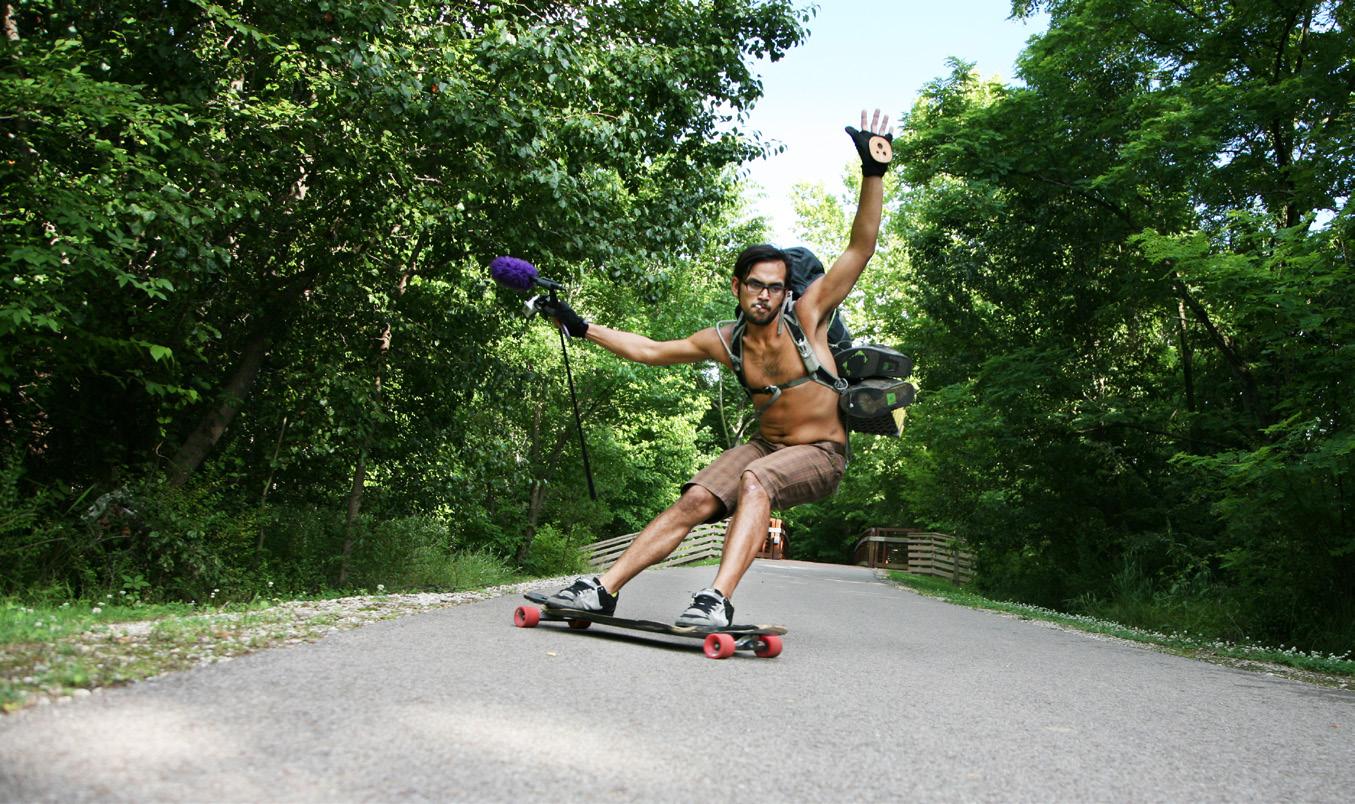
is up to you. It’s also a bit different than planning a road trip, so instead of gas stations, you’ll want to make sure you have stops for water and food planned out. While the country or area you’ll be skating through is one factor, planning relies on the basic premise of looking for cities and lining them up. “I planned the whole route at once,” Balongie says. “I just looked at major cities and connected the dots.”
Connor Smith also diligently preplanned the route for his skate between Plymouth Hoe and Brighton Pier in England. He made the journey to raise money for Great Ormond Street Hospital in London, where he’d had surgery to remove a tumor behind his left eye caused by a rare condition called Langerhans cell hystiosis, or LCH. He says his journey was the least he could do for the hospital that saved his life. Since some roads along the English countryside weren’t conducive to skating, he’d ride ahead in a support car at times to preview the route before skating.
Darrian Balongie. Photo: Brittney Scales
Courtenay says he had a brief idea of which roads he’d take across Japan – and fortunately, the road signs were typically in English and Japanese – but relied on Google Maps to keep him on track.

You might think the last days of the journey would be the worst, with aching muscles and a worn longboard. Yet it’s the first days that often prove the hardest. The country roads of Plymouth were a constant uphill battle for Smith, as was the heat wave rolling through England’s countryside. “I thought, bloody hell, if I’ve got another nine days of this …” he says. “But actually it did get better after that.” Balongie reported similar trepidations starting out. “I was very intimidated at first, but after the second or third day I was like, ‘Man, I got this,’” he says. “When it was fun, it was really fun. When it was work, it was a lot of work.”
Even if you realize that the first few days could be the toughest, you’ll likely need more motivation to push through to the end. This is where having a higher purpose for your journey can help. It’s
no coincidence that longboard treks are so often paired with raising money or awareness – or both – for a cause, a cause that empowers and motivates when the road gets tough.

You know that a long day of longboarding will leave you hungry. But consider that how you fuel up will affect how far you go. Even if you’re relying on snacks in your backpack or from gas stations at times, keep some nutrition pointers in mind. “Sixty to 65% percent of your daily calories should come from good complex carbohydrates. They should be the foundation of your meal,” says Elaine Hastings, a Florida-based dietitian and sports nutritionist who has worked with Olympic gold medalists and other professional athletes. She also recommends laying off the refined sugars and avoiding too much caffeine to prevent crashing (nutritionally speaking, that is), and hydrating by alternating between water and a sports drink.
Even if it’s an energy bar or other backpack snack, eat something with
carbs and protein within 15–30 minutes of finishing skating to avoid dipping into reserved energy and potentially losing muscle, Hastings says. Plan to have a full meal within an hour or two after a session.
When preparing for your skate, get your diet in shape too. “You want to do in preparation and training what you’re going to do for your trek,” Hastings says, so eat the same beforehand as you plan to on the road. She recommends getting your diet in synch at least a month from your start, if not two or three months out. “If you don’t have the nutrition behind what you’re doing, your body’s not going to work for you.”
Preparation for a long trek remains essential. Yet experience will be your best resource, and every day on the road, every push, will mean more experience. Advice can’t replace experience, but when you’re starting out, it’s an asset best not overlooked. Prepare wisely, and keep on pushing.
“I was very intimidated at first, but after the second or third day I was like, ‘Man, I got this‘...”
-Darrian Bolongie
Darrian Balongie. Photo: Brittney Scales
THE SEVEN-YEAR PITCH
KOZAKOV CHALLENGE LIVES UP TO ITS REPUTATION
By James Gogarty
Just over 100 kilometers northeast of Prague, the “thousandspired” capital of the Czech Republic, a 4- to 6-million-year-old volcano slumbers high above the pastoral Bohemian landscape. While not the grandest peak in the region, for speedboarders worldwide this place is as epic as they come. With its three hairpins and steep straightaways on a smooth but narrow asphalt road to its 24-hour party, rowdy fans and drastic weather changes, Kozakov challenges the very best boarders.
This eruptive track is 3 km long and starts at a shady length at the hill’s peak. It drops quickly and opens onto a clear-cut slope, where scorching sun or pelting rain can blast riders as they sail into the first switchback. Riders then find themselves on a straightaway, entering a forest with a thick canopy where light and darkness dance chaotically upon visors. Two sharp hairpins quickly reveal themselves, while the crowded conifers hide the dangers of jagged rocks and deep streambeds. The
trees begin to open up, revealing flashes of the panorama below. Coming out of the forest, the road straightens, and speeds often reach over 100 kph. Like pyroclastic flow from this once-active volcano, speedboarders fire into the unsuspecting farmland below, crossing the long, flat finishing stretch and leaving lava-like ’thane and rubber behind.
2015 marked the Kozakov Challenge’s seventh year, and it’s come a long way since its first year in 2009, with some well-received added features. These included a small but aggressive mini ramp next to the hilltop campsite, which kept the nervous legs of both fans and competitors satisfied, if not bloody and bruised, throughout the day and into the twilight. Even Heiko Schöller, the founder of Cologne’s Concrete Wave skate shop, could be found slapping smiths along the coping. A few meters away, visitors could also test their balance, or lack
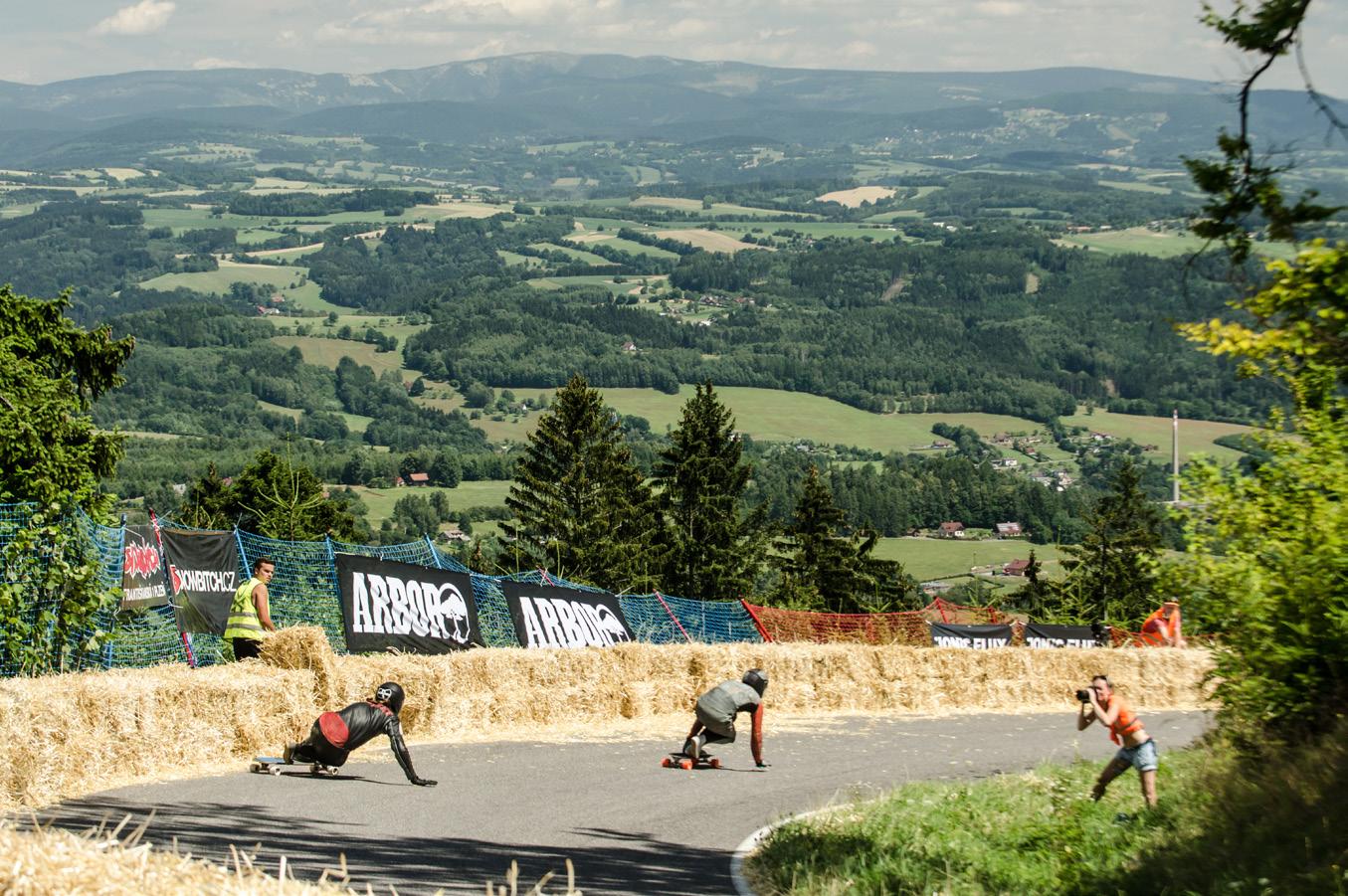
86 | CONCRETE WAVE - WINTER 2016
Photos: Jirka Livora
thereof, on the two newly introduced slacklines. Thursday night saw the premiere of Longboard Girls Crew’s skate doc, OPEN, drawing fans in from the dark into the large party tent that has been a staple at Kozakov for many years.
The Kozakov Challenge has always stood apart from other races due to how it has successfully integrated the pros, amateurs and fans. This fact is not lost on top rider James Kelly, who’s raced at Kozakov five times. “It’s great how accessible the course is for spectators, especially at some of trickiest hairpins,” Kelly says. “It’s a tight-knit event, with the campsite and parking at the top of the hill as well as the ceremony tent, ensuring riders and fans stay together – unlike other events where most riders leave for their hotel by car after the race day.”
Despite its current status, Kozakov’s origins are humble. Founder and current chairman of the Czech Gravity Sports Association, Jan Profous, a longtime classic luge enthusiast, was inspired while visiting an International Gravity Sports Association race in Almabtrieb, Germany, in 2008. “The people were so nice, and the event didn’t look so difficult to organize,” he says. “I was determined to host a similar race in Czechia to show them our hills but soon found out how difficult it was.”
For years Profous and some friends had been scouting for the perfect road to hold such a competition. When one of the first local experienced riders, Stephan Risch, invited them to a backwoods village in North Bohemia and introduced them to the now infamous 2921 route running up and over Kozakov, they knew they’d found it. They sent a video of the track to IGSA President Marcus Rietema, who subsequently granted them a license for the European Championships. A year later CGSA was born.

Then came the arduous task of getting permission from the local government to use the hill. It was, and continues to be, a long and difficult procedure for CGSA. “Nerves of steel were needed,” Profous says, “but the powers that be in this region were surprisingly more cooperative than expected, and they helped move the process along.”
After half a year of sleepless nights, the summer of 2009 saw the first Kozakov Challenge. Profous says he clearly remembers when the first rider was on the road. He had been up all night with his scratchpad, nervously reviewing all the notes he had taken since January. He says he remembers thinking, “Who would have thought from just three individuals first exploring the hill, that we would have 120 international riders ready at the starting mark?”
In fact, 160 riders had registered, which was a grand moment for CGSA. However, 40 of those riders
didn’t show up, which nearly bankrupted the organization. But in an act straight out of a feel-good Hollywood film, the riders got together and created a charity on site. “Alex Luxat even sold his leathers and board to donate cash to the cause,” Profous says. “All this unbelievable generosity helped us survive the year. … Without their help, there wouldn’t be any further Kozakovs.”
CONCRETEWAVEMAGAZINE.COM | 87
Patrick Switzer eyes his line through a fast right-hander.
The following year, Kozakov Challenge was named the IGSA World Championships, and the number of racers continued to increase. The 2015 race hosted 220 riders and almost 10,000 spectators. Yet despite this growth, CGSA still ensures that all riders get in at least 10 freerides and that fans have access to key viewing spots.
In the early years the atmosphere of the event was a bit different from the grand reputation it now holds as a top race in the International Downhill Federation (which took over the race’s sanctioning from the IGSA in 2013). “Everyone was goofing around and having so much fun,” reminisces seven-year Kozakov veteran Patrick Switzer. “We didn’t necessarily show off any crazy skills on the track; we just had a ridiculously good time.” This year, Switzer could be seen doing giant stinkbug slides around the tightest turns and tucking into incredible speeds on the straights.
Early on, Kozakov was also more of a European event. “In 2010, my first year,” says Marie Bougourd, currently the IDF’s No. 2-ranked female rider and a previous winner at Kozakov, “a lot of French people attended, and we only kept to our little group on and off the track.” Now you’re more likely to find Bougourd strategizing with her American boyfriend and top 10 contender, Kyle Wester.
In fact, if you look at KC’s registration, it reads like a list of U.N. diplomats,
with countries from every continent represented. The road was repaved shortly before the very first competition and has remained in good condition – mostly. As No. 1-ranked and current IDF World Champion Kevin Reimer points out, “It has changed over the years, and the pavement has progressed in a poor way, with tar patches at the top and oil stains along the way; but, unfortunately, not much can be done with this.” Regardless, the road still continues to impress riders. “It feels like the track was purposely built for downhill skateboarding,” Wester says. “The width is perfect. It’s fast and very technical.”
These aspects haven’t been lost on other riders. “In the 2011 finals,” Kelly says, “I was speeding into that first right and I crashed and I high-sided. I remember flying backwards – it was one of the scariest moments I’ve ever experienced – going 80 K. Luckily, I backflipped and landed sitting against the hay barriers.” After taking off his helmet he realized he was OK – a bit shaken, but ready to race another day. In 2015, Justin Rouleau,
who was skating with a broken kneecap, found the track’s intensity too much. His knee gave out and he slammed hard; both he and his helmet were cracked, and he had to pull out of the race.

Not all of the stories are so dramatic. Reimer and others follow the Czech national pastime of foraging, picking forest berries in the thick woods covering the hill between races. “We dubbed it ‘berry farming’ and we were laughing the whole time – a great way to unwind after intense racing,” he says with a smile.
Tales from Kozakov’s evening parties could fill books – not the type you would read to a child. While celebrations are to be had every night, the one after Saturday’s award ceremony is explosive. DJs mix into the early hours of Sunday while participants dance, drink to excess and partake in the nihilistic tradition of stacking the portable benches, up to eight high, and surfing them until they collapse in a loud thunder of metal and wood, and sometimes blood and flesh.
88 | CONCRETE WAVE - WINTER 2016
Charles Ouimet (front) calls Kozakov the best race in the world.
Local villagers also show up to take advantage of the cheap booze and free music, sometimes irritating the fans and riders. “While I love almost everything here, it gets really sketchy at the party,” says Canadian racer Emily Pross. “I would be nowhere near here tonight if it wasn’t for the ceremony.” The majority, however, seem to ignore the yokels and celebrate with gusto with friends old and new.
In 2015, the Czech Republic experienced its hottest summer on record. This brought swarms of angry wasps that were literally crawling out of the ground and buzzing anything and everything. Many a scream could be heard as stingers met skin. Throughout the week, riders were bombarded with intense heat and summer storms. It was wise to keep the rain wheels close at hand.
The forecast on the final day promised a storm, although the clouds looked light and high. Much to the chagrin of the riders, the organizers decided to shorten the track, similar to 2012. Although not a drop of rain had fallen, both the starting and finishing line were drawn closer. Frustrated riders could be heard complaining about the lack of speed and about losing important turns. Then just minutes before the semifinals, the sky
darkened, the wind strengthened and the heavens opened up. Rain and wind blew so intensely that up at the campsite, marquees and tents were being tossed around in the air and frantic fans ran for shelter under the more stable ceremonial tent. On the track, it took several people just to hold down the starting-line shelter and keep the race going.
The riders quickly switched to their rain setups and rallied for a wet ride. “Despite the rain, there were the most spectators I’ve ever seen!” noted Kozakov newcomer Loryn Roberson. After the 20-minute tempest, the racers pushed off and braved the new conditions into the finals. In the end, first-time attendee Pross beat out veteran Bougourd and Lyde Begue to win the women’s division. “I was so pissed when they shortened this amazing track while it was dry,” Pross
says, “but it was totally worth it, since after the storm my foot was on the road more than on the board, footbraking.”
Surprisingly, many of the favorites in the open class were knocked out early, including Reimer, Switzer, Australia’s Connor Ferguson and Germany’s Seb Hertler. Only Brazil’s Carlos Paixão was a repeat finalist, coming in third. Americans and Kozakov first-timers Jimmy Riha and Byron Essert upset the ranking by taking first and second, respectively.
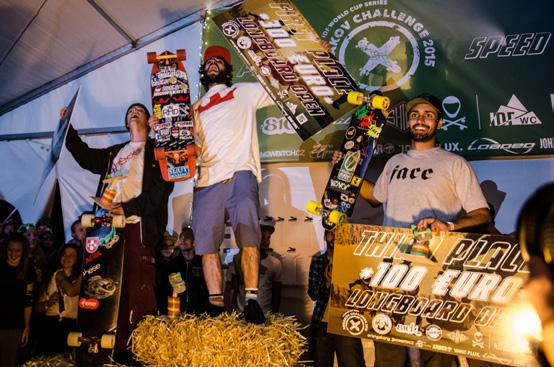
With several of last year’s juniors moving up to Open this year, it was anyone’s guess who would take the junior division. It turned out to be Canada’s Alex Charleson, who finished before Norway’s Jørund Bratset and Czech racer Vašek Čvančara. As the only Czech on the podium, Čvančara brought about the wildest cheers during the awards ceremony.
After all the formalities, it was time for the fiery party to begin and continue ’til the crack of dawn. Another successful Kozakov Challenge had passed, and the minions of downhill eagerly began to await the next.

CONCRETEWAVEMAGAZINE.COM | 89
“While I love almost everything here, it gets really sketchy at the party...” -Emily Pross
Connor Ferguson out in front.
2015 Open podium: Byron Essert, Jimmy Riha, Carlos Paixão
PUBLISHER/EDITOR: Michael Brooke - mbrooke@interlog.com
COPY EDITOR: Jonathan Harms
ART DIRECTOR/DESIGNER: Stacy Lowery
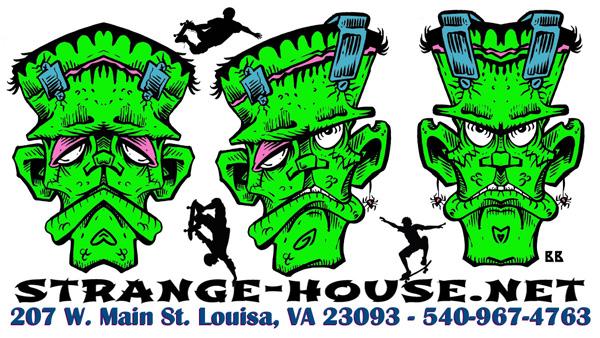
ASSOCIATE EDITOR: Joseph Friedmam
INTERN: Danny Fedkenheuer
CONTRIBUTORS: Adam Lapierre , Artem Vladimirov, Mark Short, Seth Shapiro, Lori George, Maxime Lassale, Holger Schickor, Andreas Nout Schmidt, Matt McDonald, Jim Hegan, Noelia Otegui, Masayuki Sano, Ingmar Solissa, Cameron Bowser, Daniel Freauf, Monty Little, 49n, Sawako Fujii, Jim Goodrich, Harvey Hawks, Meredith Estel, Keith Gillogly, Tom Ballinger, Brittney Scales, James Gogarty, Jirka Livora
HEAD OFFICE: 1136-3 Center Street, Suite 293, Thornhill, Ontario, L4J 3M8 Ph: 905.738.0804

CANADIAN DISTRIBUTION Inward Supply 514-996-7138 Landyachtz 778-785-6855
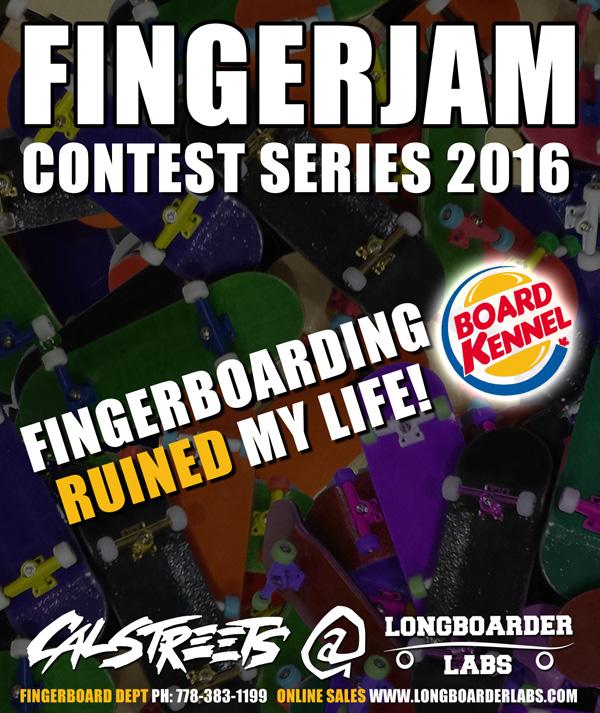


Concrete Wave is published by North of La Jolla Inc. Subscriptions (6 issues) are US$26 FIRST CLASS or CAN$26. Address change? Mag not arriving? Contact us - don’t go postal. We can sort it out. mbrooke@interlog.com.
Publisher’s permission is required before reproducing any part of this magazine. The views and opinions expressed in Concrete Wave are not necessarily those of the publisher. Printed in the USA.
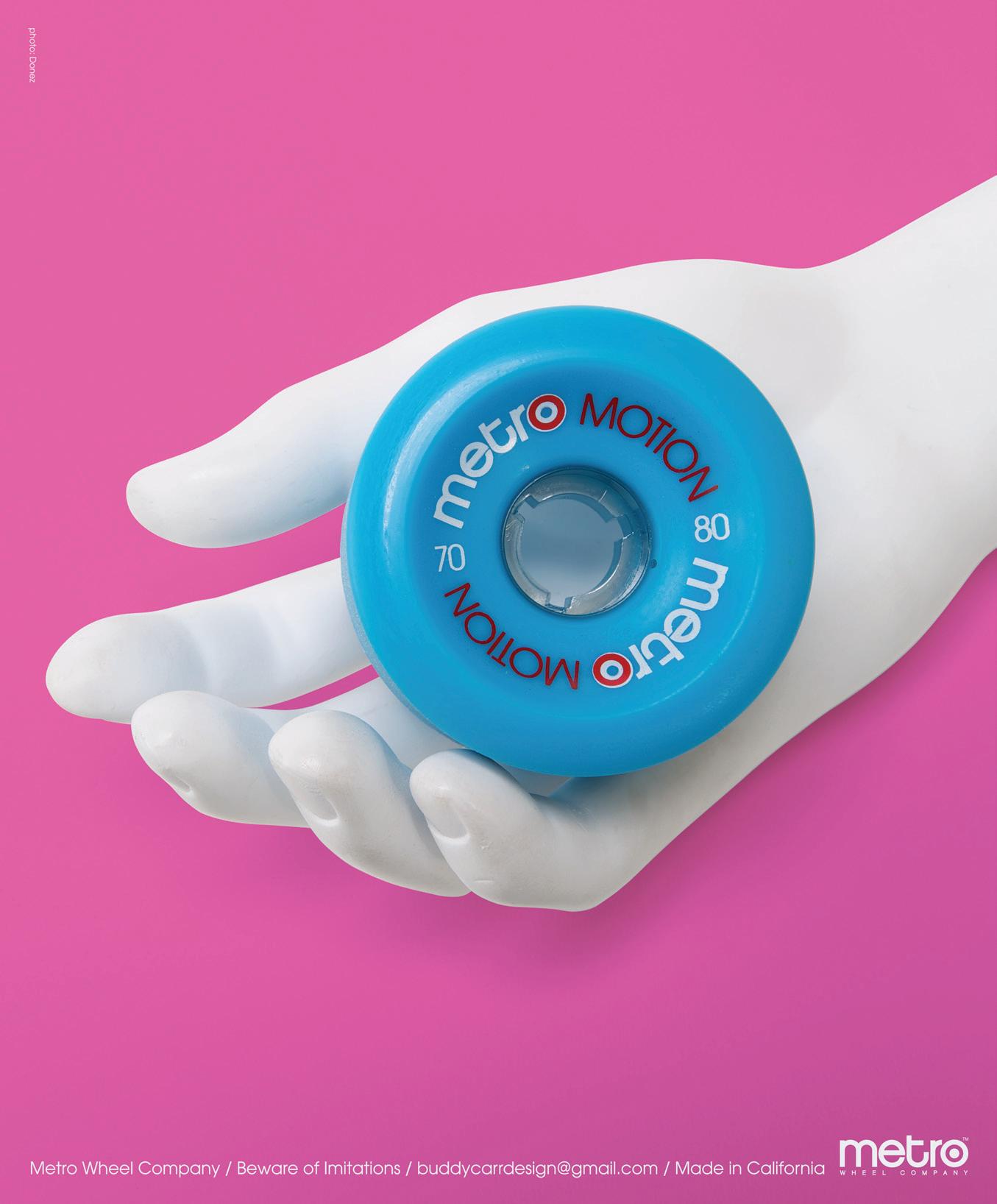

92 | CONCRETE WAVE - WINTER 2016
















 R: James Kelly P: Dustin Damron
James Kelly pro model
SLIGHT ROCKER | WHEELBASE OPTIONS | KICKTAIL
R: James Kelly P: Dustin Damron
James Kelly pro model
SLIGHT ROCKER | WHEELBASE OPTIONS | KICKTAIL




 photo: budro
photo: budro








 Michael Brooke Editor
Michael Brooke Editor




































 by Luke Ayata
by Luke Ayata
























 Photo: Maxime Lassale
Photo: Maxime Lassale






 By Andreas Nout Schmidt
By Andreas Nout Schmidt



















 Photo: Masayuki Sano
Photo: Masayuki Sano

 Photo: Cameron Bowser
Photo: Cameron Bowser





 Mic Murayama
Japan
No-hand pogo to primo. Photo: 49n
Mic Murayama. Photo: 49n
Mic Murayama
Japan
No-hand pogo to primo. Photo: 49n
Mic Murayama. Photo: 49n





 By Harvey Hawks Photos: Meredith Estel
By Harvey Hawks Photos: Meredith Estel






































 Lance Smith
Erick Chezlac
Lance Smith
Erick Chezlac



















 Grant Brittain
Lance Smith
The inventor of the frontside air, Tony Alva, pops one off of the Tracker ramp under heavy skies, circa 1978.
BELOW: Larry Balma employs the sledgehammer stress test on a Tracker Street Track truck, 1992. OPPOSITE PAGE, CLOCKWISE: Vert master Lester Kasai launches skyward, late 1980s. Rob Dyrdek tackles a long rail, early 1990s. Per Welinder brushes up on his freestyle in San Francisco, California, 1983.
Grant Brittain
Lance Smith
The inventor of the frontside air, Tony Alva, pops one off of the Tracker ramp under heavy skies, circa 1978.
BELOW: Larry Balma employs the sledgehammer stress test on a Tracker Street Track truck, 1992. OPPOSITE PAGE, CLOCKWISE: Vert master Lester Kasai launches skyward, late 1980s. Rob Dyrdek tackles a long rail, early 1990s. Per Welinder brushes up on his freestyle in San Francisco, California, 1983.




















 Connor Smith. Photo: Tom Ballinger
By Keith Gillogly
Connor Smith. Photo: Tom Ballinger
By Keith Gillogly
















